

Preceding page Lots 20 & 21 [detail] Left Lots 55, 53 & 52 [detail]



Preceding page Lots 20 & 21 [detail] Left Lots 55, 53 & 52 [detail]
Sale Number LT749
info@lyonandturnbull.com
Colin T. Fraser Consultant Specialist & Head of
Sale colin.fraser@lyonandturnbull.com
This auction will be held live online, saleroom bidding will not be available.
Please see the guide on page 308 for online, telephone & commission bidding options.
Kier Mulholland Junior Specialist kier.mulholland@lyonandturnbull.com
VIEWING
Lyon & Turnbull 33 Broughton Place Edinburgh EH1 3RR
Saturday 13th May 12 noon-4pm
Sunday 14th May 12 noon-4pm
Monday 15th May 10am-5pm
Tuesday 16th May 10am-5pm Wednesday 17th May 10am-5pm
Thursday 18th May 10am-5pm
Day of sale from 9am by appointment
The Matrix Collection has been carefully compiled by the late Mr. David Morris. An avid collector in the traditional sense, his passion continued throughout his life resulting in the formation of a significant collection. Morris always showed a keen interest in Scotland, exemplified by the 1984 sale at Christie’s of the first section of his collection of Scottish Provincial silver, still to this day the most significant collection of Scottish silver ever sold. The collection contained many great rarities which were secured by institutional buyers and the largest collectors of the day, few of which have retuned to the market since.
His thirst for knowledge within his collecting fields can be also be seen within his library on silver and related crafts, considered one of the finest amassed, which was offered by Woolley & Wallis in 1995.
David’s attention to detail and interest in historic hand seals was fuelled by the desire to create more accessible material on the subject, “the wealth of interesting pieces in the reserve collections of our leading museums seldom sees the light of day.” He collected the seals for their historical interest as well as their beauty, showcased in his important publication Matrix: A Collection of British Seals
The Matrix Collection focuses on Great Britain and its international links. Looking at the domestic history but also how Great Britain influenced the rest of the world, on the Continent and further afield. The seals have the ability to show us key moments in history whether this be highlighting the important individuals who used them to correspond and officiate key moments or the foundation of noteworthy organisations. The seals go far beyond their function, they offer an insight into the political and social context of their day as well as reflecting the fashions of the owner.
Pre-dating writing, seals were used the same way as signatures are today. They authenticated documents such as charters, letters, writs and are also used to seal documents for correspondence. Consequently, they begin to reflect the owner’s personality, whether that be functional or flamboyant.
The rise in seals with handles, regularly called desk seals, occurred in the 16th and 17th centuries with the rise in the notion of a desk as a fixed piece of furniture. As silver came to the forefront at the same time, the material which lent itself to the engraving of heraldry became a favoured choice for matrix’s and mounts. Designated for the wealthier echelons of society, this addition of precious metal and stones rose alongside the popularity of the Grand Tour.
As the wealthy travelled through Europe absorbing Classical art and antiquity they acquired rare, beautiful and exotic hardstones, a turning point leading to the seals themselves truly becoming works of art. By the 19th century seals certainly became objet de vertu.
Their appeal is widespread, from personal use to that by societies and business they transcend all facets of society. The interest found by Morris in these stories was a driving factor in his collecting. The beauty, care and, no doubt, cost in creating these pieces for newly formed businesses or societies shows the importance of an armorial, insignia, and seal. Those created when an elevation or change in society by marriage or inheritance necessitated a new armorial and seal were particularly important, being some of the finest and most elaborate to survive.
Although, there is not much known about those who made them, it is generally accepted that a ‘toyman’ would have been the first point of contact for purchasing. ‘Toyshops’ in the Georgian period sold desirable luxury items, including, etuis, jewellery, watches, travelling cases, snuff boxes and much more, in gold, silver or even pinchbeck. Many hands worked on the seals with the handles from one workshop, and the engraving and matrices from another.
These portable works of art offer a glimpse into a time when armorial and insignia had far more immediate meaning, they show us art in miniature and craftsmanship at its best. Perhaps most tantalising is that each piece tells us a different story, taking us to a different time and place.

Note: This seal was made for Archibald Kennedy, 3rd Marquess of Ailsa (1847-1938), who succeeded his father in 1870. He founded the Ailsa Ship Building Company in 1885 and spent much time restoring and improving the family seat of Culzean Castle. The Kennedy family which descends from Robert the Bruce, is one of the oldest families in Scotland, and the grandeur of the castle was intended to reflect its status. The present castle on the Ayrshire coast was designed by Robert Adam for David Kennedy, 10th Earl of Cassilis, to replace a simpler house. It was built in stages between 1777 and 1792 and incorporates a drum-shaped tower overlooking the Firth of Clyde and an elegant oval staircase. The 3rd Marquess’s improvements included constructing a more practical entrance to keep out the fierce clifftop winds and rehanging the vast collection of weapons in the armoury. It is not surprising that he should choose this romantic view of the castle, taken from an engraving dated 1840 for this seal.

THE ARCHIBALD KENNEDY (1847-1938), 3RD MARQUESS OF AILSA AND EARL OF CASSILLIS, CULZEAN CASTLE DESK SEAL A FINE MID-VICTORIAN CITRINE, BLOODSTONE AND GOLD MOUNTED DESK SEAL
the facetted tapered citrine handle with engraved crest within garter with motto surmounted by coronet to pommel, the stylised leaf clasped mount enclosing a rounded square bloodstone matrix finely engraved with a view of Culzean Castle from the beach with ‘Culzean Castle’ engraved below, in a fitted case


Length: 97mm, matrix 21mm x 24mm
Provenance: Shapes, Edinburgh, 4 July 2009, lot 31
Matrix: A Collection of British Seals - David Morris 2012- Seal 30, page 77 £1,200-1,800
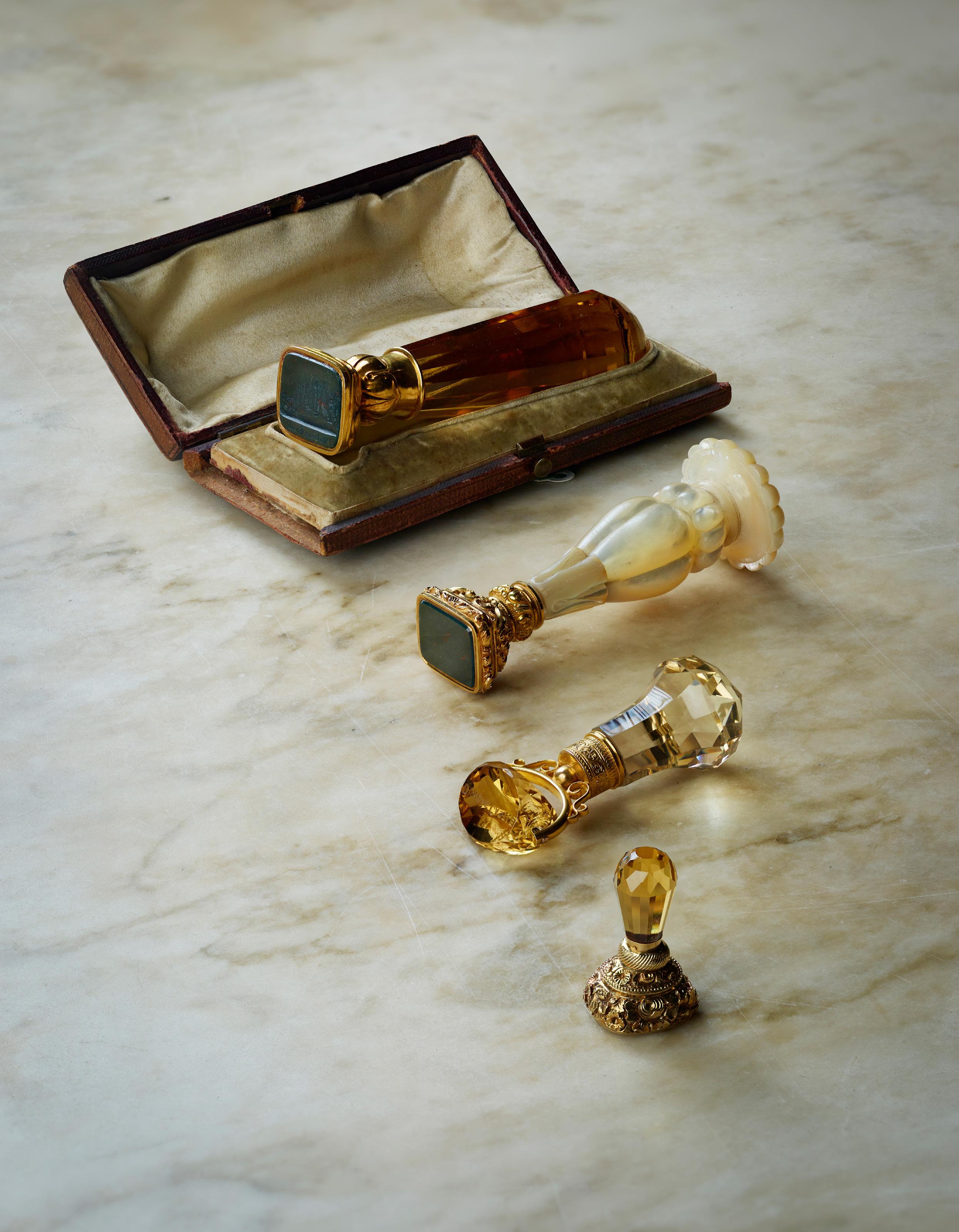
A MID-VICTORIAN GOLD AND CITRINE THREE-SIDED SWIVEL SEAL, CIRCA 1850
the facetted citrine baluster handle collet set with engraved trailing foliate gold collar, the scroll frame to three-sided oval citrine matrix, one side with a crest of a hound/ wolf’s head facing left, one inscribed DUNDAS CASTLE, the other blank
Length: 66mm (overall), matrices: 19mm x 22mm
Note: A castle has been in situ on the grounds of Dundas Castle since the early 15th century, and there is still the ‘auld keep’, which dates to 1416. The current castle was fashioned in 1818 for the Dundas family by architect William Burn.
William Burn was well-known as a country house architect and pioneered the Scots Baronial style which Dundas Castle reflects. He worked on renovations to other key estates in Scotland including Lauriston Castle and designed the Melville Monument in St. Andrew Square, Edinburgh.
Unfortunately for the Dundas family, the renovations cost so much that the estate had to be sold and in 1846 was purchased by Mr. Russell, who was the founding partner of Edinburgh law firm Russell & Aitken. It is perhaps at this time that the seal was commissioned, accounting for the ambiguity of the crest. The house has been in the possession of the current Stewart-Clark family since 1899, suggesting that this seal is perhaps a snapshot of quite a short period of history for this South Queensferry estate.
£600-900


the short tapered and facetted citrine handle set to a boldly chased spiralled and floral mount enclosing a square citrine seal, the seal engraved with a Duke’s coronet above the crest of a falcon standing on a perch, with script motto



‘Breakfast’ below
Length: 33mm, matrix 20mm x 18mm
Provenance: Christie’s London, 24th May 2000, lot 259
Note: The combination of co-wrote, coronet, crest and apparent motto have not been possible to attribute to any family or person. There are various possible families connected to the crest, but none are entitled to a Ducal coronet. The motto ‘Breakfast’ equally adds confusion. It has been previously considered as a personal joke given at a time now long forgotten.
£500-800
CIRCA 1810
the carved mother-of-pearl handle to a chased gold collar, the hinged terminal opening to a glazed compartment with a lock of hair, to a vacant bloodstone matrix


Length: 85mm, matrix: 11mm x 18mm
£700-900

THE PERSONAL DESK SEAL FOR GEORGE ECKFORD
A MID-19TH-CENTURY WOODEN AND STEEL DESK SEAL
the ebonised wooden handle of baluster form, the steel collar with a gadrooned waist to a circular integral matrix, engraved with an augmentation as a Knight of the Order of St. John in a border ‘SIGILLUM GEORGII ECKFORD’

Length: 11.5cm, matrix diameter: 34mm
£200-300
THE PERSONAL DESK SEAL FOR EDWARD BURROW (1726-1800)
A LATE 18TH-CENTURY HARDWOOD DESK SEAL, CIRCA 1773
the hardwood handle of triple knopped form, to a metal collar with banded decoration, the integral matrix engraved with the arms of Burrow
Length: 10cm, matrix: 20mm x 21mm
Heraldry: Arms: Argent a fess indented sable between three bezants
Crest: A lion passant guardant armed ad langued gules
Note: Edward Burrow petitioned the then Lord Lyon King of Arms for a matriculation of arms which was dated 14th August 1773
£600-800
THE HENRY ALEXANDER (1664-1739), 5TH EARL OF STIRLING DESK SEAL

A LATE 17TH-CENTURY BOXWOOD AND SILVER DESK SEAL, CIRCA 1685
the turned baluster boxwood handle indistinctly written on in ink noting original ownership, socket set with silver collar and oval matrix with engraved armorial



Length: 97mm, matrix: 30mm x 25mm
Note: It would appear this seal originally belonged to Henry Alexander, eldest son of the 4th Earl of Stirling. He was Viscount Canada from 1664 until succeeding his father in 1691. Stylistically, it would seem likely this seal was made on him reaching his majority in 1685.
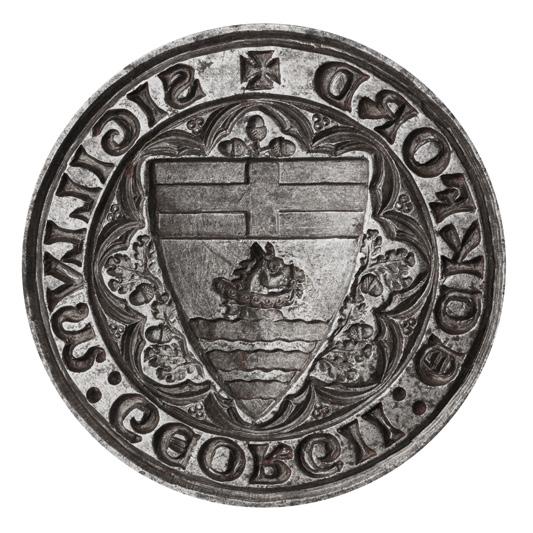
Eldest son of Henry Alexander (1633-91) 4th Earl of Stirling, and his first wife Judith (b.1664), he was educated at Eton and resided primarily at his house in Binfield but held his Scottish roots by frequently voting as a Scottish representative peer. He was retired and granted a pension of £200 a year by 1733. On his death, the peerage became dormant, and his property was distributed between his cousin and nephews.
£800-1,200
THE STUART FAMILY OF BUTE DESK SEAL



A LATE 18TH-CENTURY BOXWOOD AND BRASS DESK SEAL, CIRCA 1775
the wooden baluster handle with mushroom capped terminal, to a brass collar and integral matrix, engraved with the arms of Stuart and a martlet cadency for the fourth son and the motto NOBILIS IRA
Length: 9cm, matrix: 3.2cm x 2.7cm
Note: The Bute family can trace their lineage back to the 12th century. They have been on the Island of Bute on the West coast of Scotland for over seven hundred years and have lived on the present site for almost three centuries.
The 2nd Earl of Bute constructed the first Mount Stuart house in 1716.
But it was the 3rd Earl of Bute, (1713-1792) who first accelerated the family’s standing. In 1756 the 3rd Earl was named Groom of the Stole to the young Prince of Wales, soon to be George III. His influence helped develop both his personal philosophies and artistic tastes, with his young prince referring to Bute as his “dearest friend.” His role as First Lord of the Treasury in 1762 in effect Prime Minister this confirmed his trust.
The family’s fortune was made by the fortuitous marriage between the 4th Earl and Charlotte Jane Windsor, heiress to vast estates in South Wales, and further rewarded by his appointment, to the 1st Marquess of Bute in 1796. This relationship is mirrored with that of his purported favourite son Charles Stuart (1753-1801) who Lord Bute personally tutored. It seems possible that this seal relates to a fourth son of the Earls of Bute, likely the 4th Earl of Bute. As the fourth son, he had a military career and achieved lieutenant general by 1798. He passed away in London in 1801.
£500-800
9
THE MACMILLAN FAMILY SEAL
AN EARLY 19TH-CENTURY SILVER-GILT MATRIX, CIRCA 1815
the oval discoid seal with engraved crest and motto ‘MISERIS
SUCCURRERE DISCO’, in a rope twist border
Length: 36mm
£200-300
10
A MID-VICTORIAN GRANITE, SILVER AND CARNELIAN DESK SEAL, CIRCA 1869
the baluster pink granite handle with fluted domed terminal enclosing a rectangular matrix engraved with armorial and motto
Length: 85mm, matrix: 21mm x 18mm
Heraldry: Arms: Argent a lion passant guardant gules imperially crowned proper between three quatrefoils sable on a chief engrailed of the last a martlet of the first Crest: A demi-angel proper
Motto: Pur sans peur
Note: Robert White (born 16th August 1802 died, 9th June 1886), of 23 Drummond Place, Edinburgh. Robert was the second surviving son of Adam White of Fens in the County of Roxburghshire and his wife, Catherine Ogilvy. He was by profession a Writer to the Signet having been admitted to the Society of Writers to the Signet on the 13th December 1827. Robert married Anne Reid Fogo (born 9th September 1823 died 23rd October 1905), the daughter of Thomas Macmillan Fogo, MD and his wife Anne Scott at the Parish Church of St Mary and St George, Edinburgh, aforesaid on 3rd June 1852. Robert petitioned the Lyon Court for matriculation of arms which was dated 2nd April 1869 [Lyon Register Volume 8, Page 31].
£400-600 11
A BARON’S DESK SEAL

AN EARLY 20TH-CENTURY GEM-SET AND ROSE QUARTZ DESK SEAL

the rose-quartz handle of simple form with a domed terminal, the collar set with three foil-backed amethyst cabochons, the integral silver matrix engraved with a Baron’s coronet above the initial B Length: 48mm, matrix diameter: 32mm
£300-500

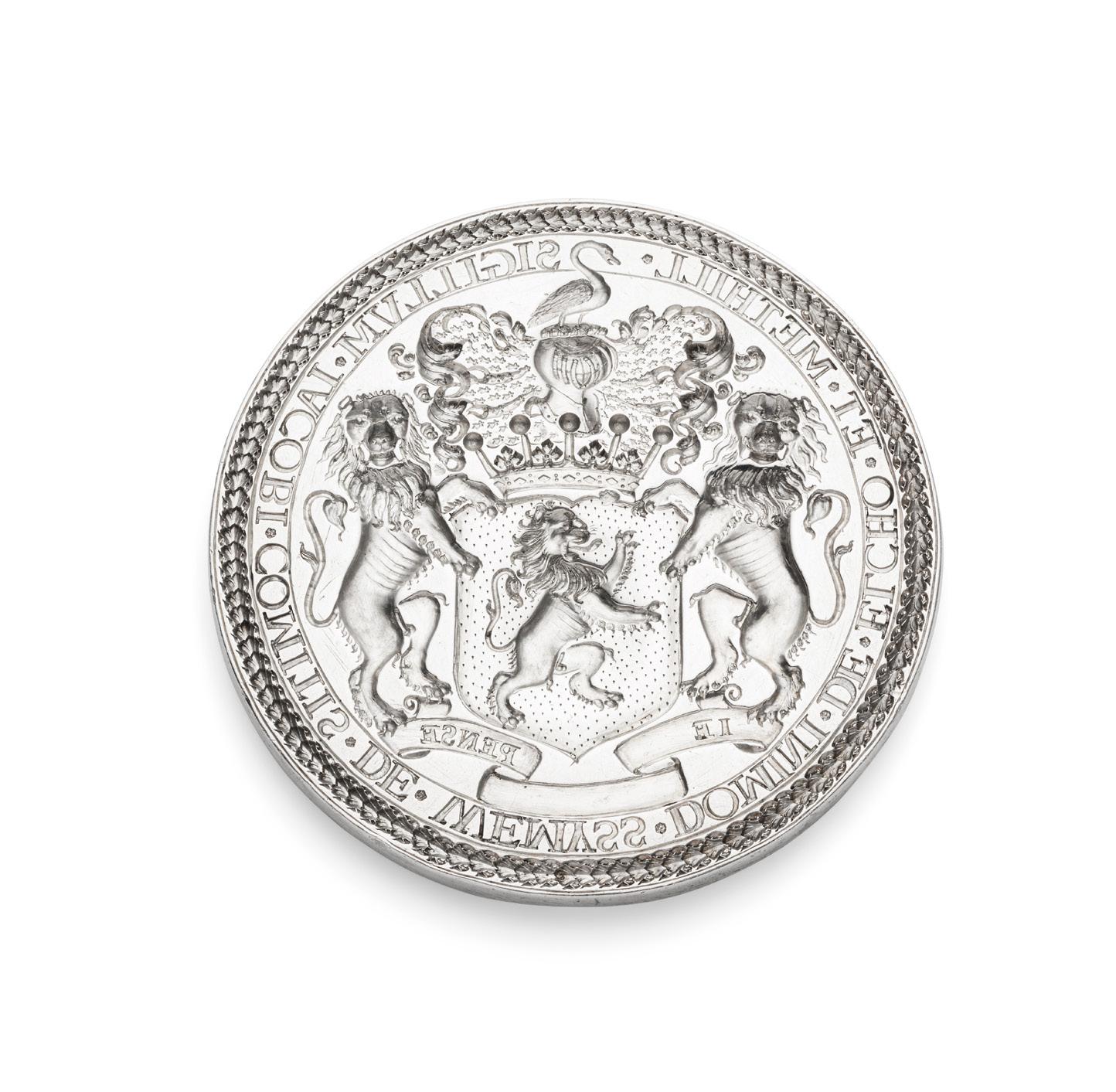
the disc shaped matrix with deeply cut armorial and motto
Diameter: 76mm, weight: 8.66oz
Provenance: Brand Inglis Ltd. Old Silver and Works of Art, 1986
Matrix: A Collection of British SealsDavid Morris 2012 - Seal 54, page 115
Heraldry: Arms: Or a lion rampant gules armed and langued azure the arms are ensigned with an earl’s coronet.
Crest: A swan proper Supporters: Two lions rampant guardant (……?)
Motto: Je pense [I think]
Note: James Wemyss was born on 30 August 1699 and was privately educated. He succeeded his father in 1720, shortly after marrying Janet Charteris. His bride, won against determined competition, was the daughter of the notorious, extremely rich gambler and money lender, Colonel Frank Charteris, who despite initial opposition to the match, ultimately bequeathed £10,000 to his son-in-law and considerably less to his daughter.
The Earl had joined the Royal Company of Archers in 1714, rising to become its Captain-General and first winner of the Company’s silver bowl trophy. Despite, or perhaps because of little interest in politics he was appointed Governor of the County of Perth in 1744, but took no active part in the Jacobite uprising in Scotland in 1745. His eldest son, David, Lord Elcho, however, commanded the lifeguard of his near-contemporary Charles Edward Stuart, the Young Pretender, to whom he had lent £3000 which was never repaid, and was obliged to flee to France. Because of this, his father was obliged to resign Wemyss Castle and the estates in favour of his third son, James Wemyss, MP for Sutherland. The 5th Earl was able to develop coal mining and salt manufacturing interests and lived for the latter part his life at Norton, Co. Durham. The loss of the provision he had made for his eldest son, combined with his estranged wife’s extravagance, had brought the Earl into financial difficulties. He died on 21 March 1756, and the title passed to the descendants of his second son, Francis.
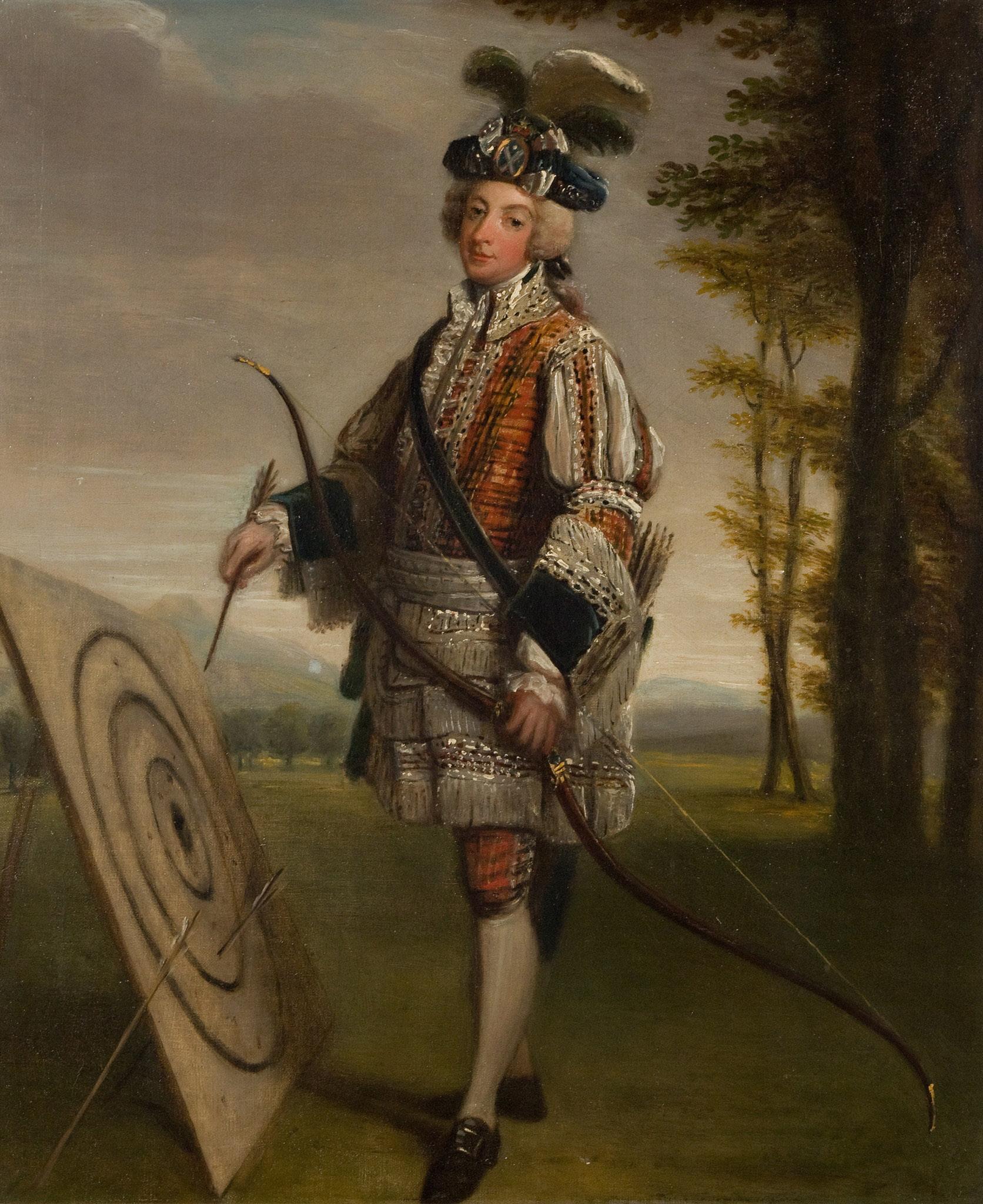
Image Courtesy of the King’s Body Guard for Scotland, The Royal Company of Archers.
£3,000-5,000
THE JAMES DOUGLAS, 2ND DUKE OF QUEENSBERRY (1672-1711) SEAL MATRIX
AN IMPORTANT EARLY 18TH CENTURY SCOTTISH SILVER SEAL MATRIX, CIRCA 1701
the large dished circular matrix with deeply carved and engraved armorial, the reverse, engraved with mirrored monogram JQ, with ducal coronet above Diameter 10.3cm, weight: 13.2oz


Provenance: Phillips Edinburgh, 3rd December 1998, lot 218

Matrix: A Collection of British Seals - David Morris 2012- - Seal 23, page 64
Heraldry: Arms: Quarterly 1st and 4th Argent a man’s heart gules ensigned with an imperial crown proper on a chief azure three mullets of the field (for Douglas) 2nd and 3rd Azure a bend between six cross crosslets fitchy or (or Mar) the whole within a bordure or charged with the double tressure of Scotland gules the arms are environed by the Garter and ensigned with a duke’s coronet.
Crest: A heart gules winged and ensigned with an imperial crown or (for Douglas)
Supporters: Two pegasi argent winged or Motto: Forward
£3,000-5,000
Note: James Douglas, 2nd Duke of Queensberry and 1st Duke of Dover was a highly important politician in 18th-century Scotland. The eldest son of William Douglas, 1st Duke of Queensberry and his wife Isabel Douglas. Educated at Glasgow University he was awarded title of Privy Councillor by the age of 22 in 1684.
He served in various regiments including Dundee’s Regiment of Horse and was appointed Colonel of the Scots Troop of the Horse Guard Regiment. A supporter of William III, it was under his reign he was commissioned as a Colonel, presumably for his support in the 1688 Glorious Revolution.
His political career was hugely successful and on the death of his father and his elevation to 2nd Duke of Queensberry, the titles and roles he held in the highest office would grow. He held positions such as Lord High Treasurer of Scotland (1693), Keeper of the Privy Seal of Scotland (1695 – 1702), and Extraordinary Lord of Session, Lord High Commissioner to the Scottish Parliament (1701-1703). His position close to the Royal Household was made even clearer in 1701 when he was appointed Knight of the Garter.
Although obviously a Royalist and in 1707 would be instrumental in securing the Act of Union, he did become embroiled, and some would say supported the Jacobite cause. He was tricked by Simon Fraser, Lord Lovat into trying to betray the Duke of Atholl to the Royal Court for his Jacobite support. This ultimately poor attempt and failed scheme meant Douglas stepped back from Government in 1704.
His fall from favour was short as the following year he was reinstated as Keeper of the Privy Seal among other roles. As mentioned, he ultimately helped secure the Act of Union which lost him many friends, but did mean he received a £3000 per year pension.
His rewards were not just monetary as he was given English titles to match his Scottish ones already held and was created Duke of Dover, Marquess of Beverley and Earl of Rippon in 1708. His career and indeed life would not last long after this and while serving as Secretary of State for Scotland, from 1709, he died in office in 1711.
He was succeeded by his second son Charles as his eldest, some considered ‘insane’; consequently passing over from succeeding his premier titles but was given the titular title of Marquess, befitting the son of a Duke.
ABERDEEN - A SCOTTISH PROVINCIAL DESK SEAL
A MID-18TH-CENTURY WOODEN AND SILVER DESK SEAL
the wooden baluster handle with flat terminal, to a silver mounted collar marked ABD, the integral matrix engraved with the armorial, possibly for the Houston family


Length: 52mm, matrix: 20mm x 13mm
Provenance: ‘Silver, The Aberdeen Story’, Aberdeen Art Gallery & Museums 2012, item 192, catalogue page 169
Matrix: A Collection of British Seals - David Morris 2012- seal 25, page 68
Note: This fine mid-18th-century desk seal appears to be the earliest marked Aberdeen example. Frustratingly, with only the town mark, ascribing a maker is virtually impossible. The quality of the silver mount and finely engraved armorial, coupled with the status of the client who commissioned the piece, shows its original importance. This type of client would likely have frequented only the most respected Aberdeen makers. Looking at the style and shape of the town punch, it does seem likely it belonged to either Coline Allan or one of his contemporaries, such as George Robertson.
£1,000-1,200
A WALLACE FAMILY FIGURAL DESK SEAL
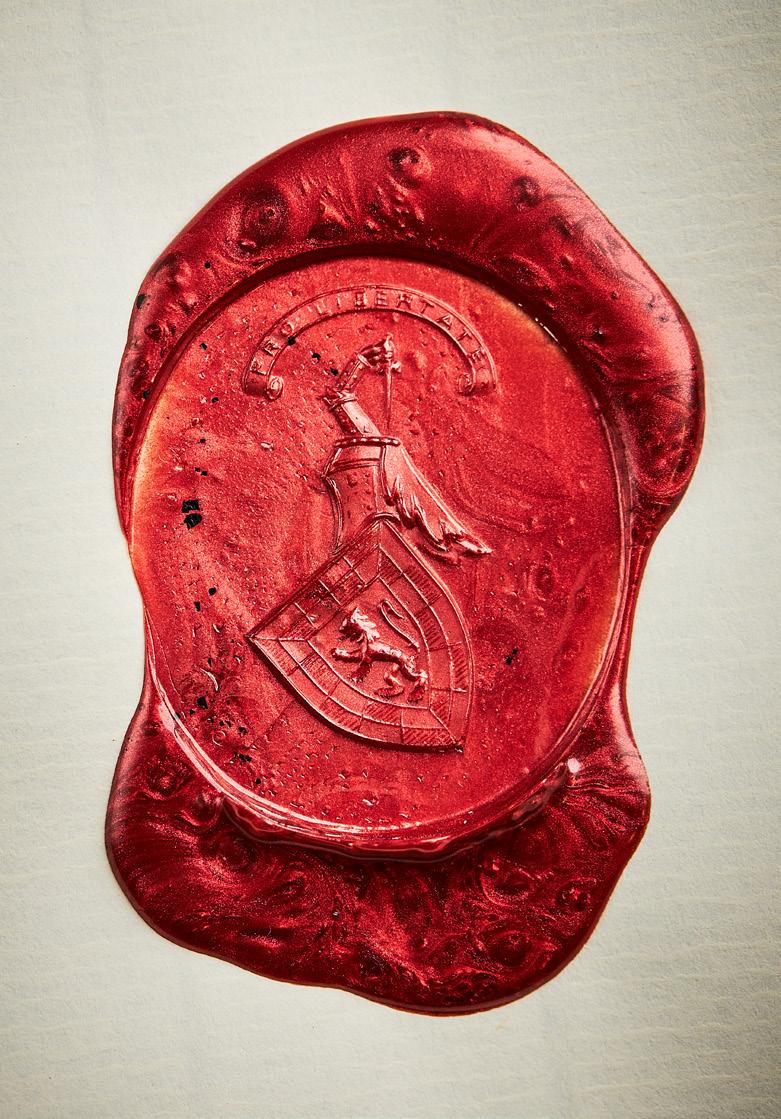
A LATE 19TH-CENTURY GILT METAL AND BLOODSTONE FIGURAL DESK SEAL, CIRCA 1870 the handle formed as the Wallace family crest of an armoured arm holding a dagger, the oval bloodstone matrix with engraved armorial, crest and motto, the matrix hinged to open a sealing wax holder, in a modern fitted case with a wax impression

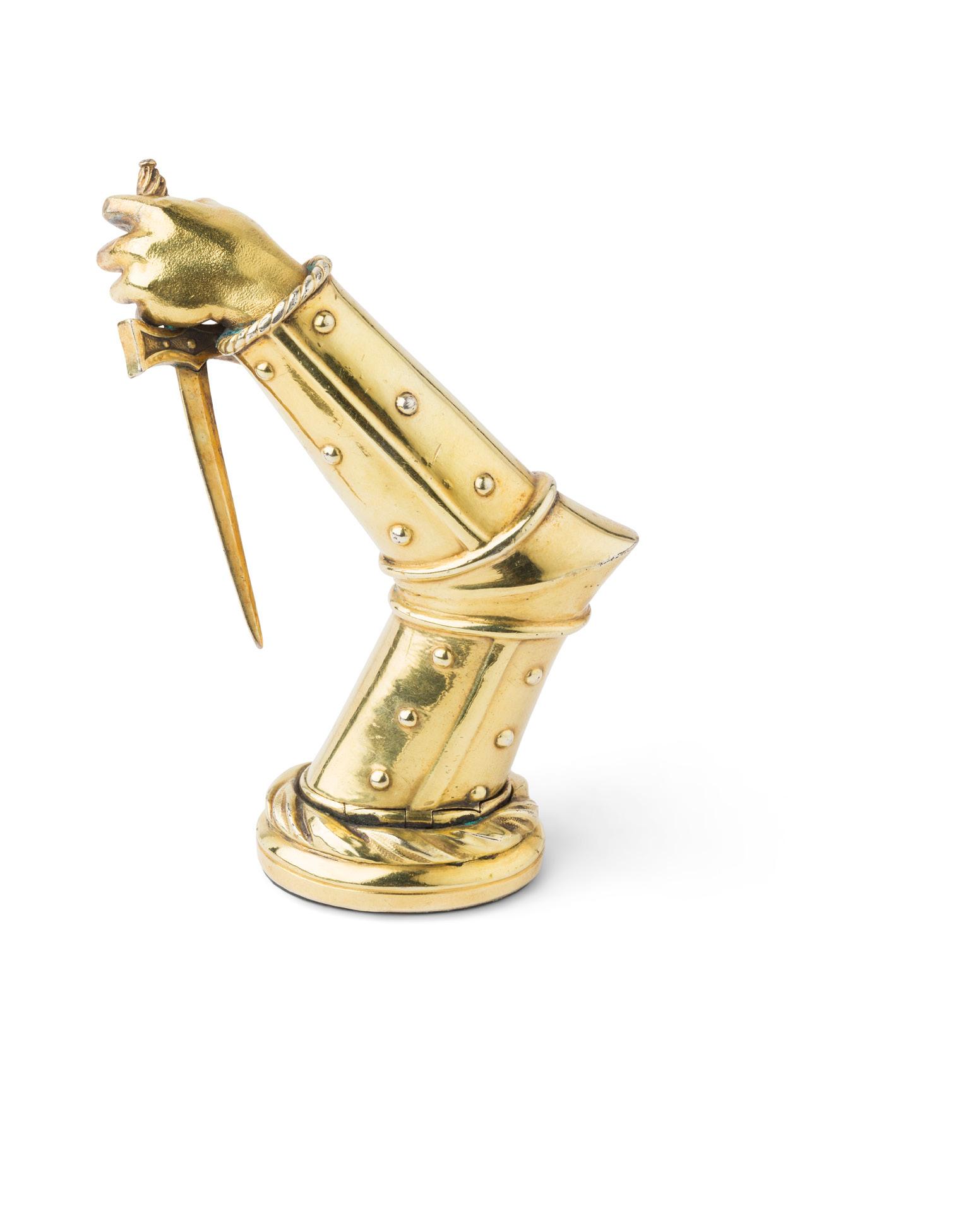
Length: 10.1cm, matrix 39mm x 35mm
£2,000-3,000
A CONTINENTAL BRONZE 17TH-CENTURY DESK SEAL

the double-ended handle of mirrored baluster form, the integral circular terminals each engraved with a lion in a shield in a border of laurels
Length: 56mm, diameter of matrices: 25mm and 19mm
£300-500

the wooden handle of baluster form with threaded detail, the circular brass matrix engraved with the crest of Robertson with motto ’Virtutis Gloria Merces’
Length: 74mm (overall), matrix: 21mm diameter

Provenance: Discovered in a house in Lauder, circa 1965
Anderson & Garland, Northumberland, 9th May 2006
Lyon & Turnbull, Scottish Works of Art & Whisky, 14th August 2019 lot 464
Heraldry: The crest as engraved upon this 18th century brass and wooden-handled Desk Seal is that of the chiefly family of Robertson of Struan. It may be blazoned as follows:
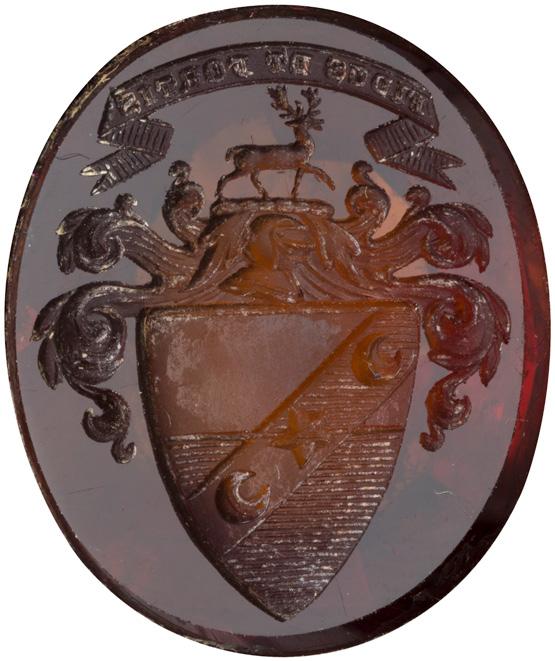
Crest: A dexter hand erect holding an imperial crown all proper
Motto: Virtutis gloria merces [Glory is the reward of valour]
Note: Alexander Robertson of Struan was a committed Jacobite. Born in 1668, he joined the Jacobite army, but was captured following its withdrawal from Dunkeld. He succeeded in escaping to France, and was subsequently attainted until 1703, when he could return to Scotland. In 1715 he again supported the Jacobite cause, raising, it is said, 500 of his clan, but was taken once more, this time at the Battle of Sheriffmuir. With the assistance of his sister, he escaped yet again, and once more fled to France. Although attainted by Act of Parliament for a second time, he could return home in 1732. In 1745, Struan was 77 years of age, yet nevertheless led 150 of his tenants to join the Prince, and, being too old himself to take up arms, returned to his home in General Cope’s carriage, which had been captured at Prestonpans, reputedly with the general’s furred nightgown and gold chain as trophies. Murray of Broughton wrote of him: “he is an old Batcheler, (sic) lived long abroad, and is reckoned a man of letters”. He was permitted to remain at Struan, and died at Carie on the Struan estate in 1749, 2000 men following his coffin 14 miles from Rannoch to Struan Kirk.
In 1725 he was reportedly created a Knight and Baronet by King James VIII. He wrote in English as well as Gaelic, and a book of his poetry was published in 1789. £600-800
18
LORD LOVAT - SIMON FRASER
A LATE 19TH-CENTURY MULTI-GEM SET DESK SEAL
the facetted agate handle set to either end with applied hardstones of various shapes including lapis lazuli, malachite and bloodstone, with a finial modelled as a stag, the ornately chased gold collar set further with varying hardstones, to an escutcheon shaped agate matrix engraved with a baron’s coronet above a cypher
Length: 73mm, matrix: 8mm x 8mm
£1,000-1,500
Note: Descendant and carrying the name of the famous Simon Fraser, 11th Lord Lovat (c.1667-1747), nicknamed ‘the Fox’, was a Scottish Jacobite and Chief of Clan Fraser of Lovat, known for his feuding and changes of allegiance. In 1715 he had been a supporter of the House of Hanover, but in 1745 he changed sides and supported the Stuart claim on the crown of the United Kingdom. Lovat was among the Highlanders defeated at the Battle of Culloden and convicted of treason against the Crown, following which he was sentenced to death and subsequently beheaded.
19
A LATE 19TH-CENTURY SILVER MOUNTED, AGATE AND CITRINE DESK SEAL
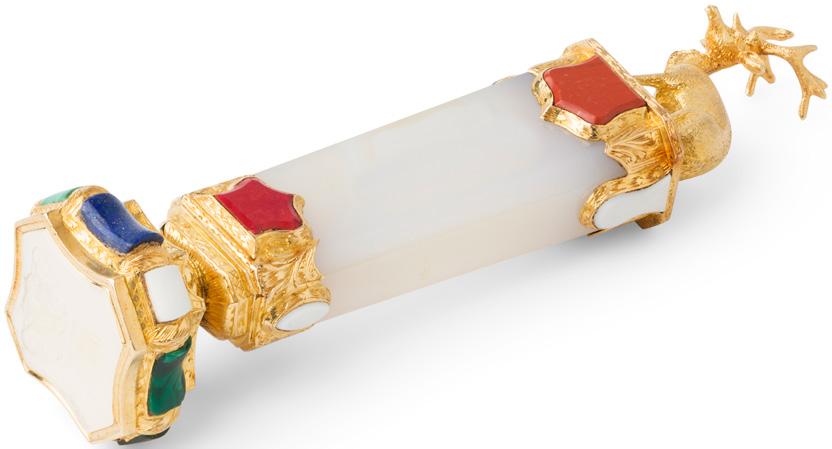
the facetted agate handle with domed terminal, to a silver mounted collar formed as a thistle to four arms, the oval-shaped, cairngorm citrine matrix engraved with the arms of the Scott family

Length: 78mm, matrix: 18mm x 15mm
Note: The arms of those of Scott. The family descends from Sir Walter Scott (15 August 1771 – 21 September 1832) ancestor of the Dukes of Buccleuch.
These arms were granted in 1864 to Dr. John Scott of Cavendish Square London (1817-1890). His son John Edward, became a trustee of the National Gallery and Wallace Collection and was created a Baronet of Castle House, Lisburn County Antrim 1899 and KCB in 1908.
The seal shows no sign of rank and must date after 1864 and before 1899, so most probably for Dr. Scott.
£250-350


the tapered hexagonal facetted lapis lazuli handle with carved heraldic shield with initials WS within, the chased domed mounts with foliate scrolls, flower heads and reeded detail, enclosing a rounded square amethyst with engraved full armorial


Length: 10.2cm, matrix 25mm x 22mm £12,000-18,000
Heraldry: Arms: Quarterly 1st and 4th Or two mullets in chief and a crescent in base azure within an orle of the last (for Scott) 2nd and 3rd Or on a bend azure three mascles of the field in the sinister chief point an oval buckle erect of the second (for Haliburton)
Crest: A nymph in her dexter hand the sun and in her sinister hand the moon all proper
Supporters: (Dexter) A mermaid holding in the exterior hand a mirror proper
(Sinister) A savage wreathed round the head and middle holding in the exterior hand a club proper Mottos: (Above the crest) Reparabit cornua Phoebe [The moon will replenish her horns]
(Below the crest) Watch weel [Watch well]
Note: This impressive and finely carved seal appears to date perfectly to the granting of the Baronetcy and Knighthood of Walter Scott in 1820. It is a classic example of Regency style and would have befitted Sir Walter Scott, now part of the Scottish gentry. His letter writing is well recorded and this piece likely sealed letters to not only the great and the good, but also correspondence destined for King George IV which would lead to his return to Scotland in 1824.
Scott’s personal interest in Scottish history and life is much discussed and his collection of historical arms and armour is famous, much of which still decorates his remarkable Borders home, Abbotsford. He also commissioned much of the finery needed for a new country estate befitting a Knight and a seal such as this would have been a hugely important gentleman’s accessory.
Sir Walter Scott was born in Edinburgh’s Old Town of Edinburgh in 1771. His father was a successful lawyer, his mother the daughter of a Professor of Medicine at Edinburgh University. After suffering polio in 1773, he was sent to his grandfather’s farm at Sandyknowe in Roxburghshire, living there until 1775, and, listening to stories from his grandfather and others, the young Scott developed his life-long love of Border history and folklore. On returning to Edinburgh, he attended the High School and Edinburgh University. In 1792, he became an Advocate, and was appointed Sheriff-Depute of Selkirkshire in 1799. This allowed him to travel across Scotland in search of history and material to use in his poetry and fiction, eventually publishing his monumental Minstrelsy of the Scottish Borders in 1802. It was in the Borders that Scott was happiest. It was there that he wrote the great epic poems ‘The Lay of the Last Minstrel’, ‘Marmion’ and’ Lady of the Lake’ between 1804 and 1810. With his fame, fortune and family growing, Scott turned to creating Abbotsford, which was completed in 1824.
Sir Walter Scott is one of the most successful authors of all time and is the second-most quoted writer in the Oxford English Dictionary after William Shakespeare. Scott’s creativity, wit and understanding of human nature remain on display in his works, but it is only through visiting Abbotsford and the Scottish Borders that one can truly understand the man himself.

THE EDINBURGH THEATRICAL FUND SEAL AN IMPORTANT ENLIGHTENMENT SCOTTISH GOLD, BOXWOOD AND AGATE DESK SEAL, CIRCA 1819 the turned box-wood baluster handle with an inlaid gold circular plaque engraved ‘Presented by W. H. Murray Esquire to the Edinburgh Theatrical Fund’, the gold stem with chased floral garland on a domed oval reeded mount, enclosing a mottled red and white agate matrix, engraved with motto INSTITUTED APRIL 2, 1819 THE EDINBURGH THEATRICAL FUND within garter surrounding the crest of lyre and thistles

Length: 92mm, matrix: 30mm x 20mm
Provenance: Matrix: A Collection of British Seals - David Morris 2012- Seal 29, page 75 £1,500-2,500

Note: The Edinburgh Theatrical Fund for the support of indigent and retired actors was founded in 1819 by Harriet Murray Siddon (Mrs Henry Siddons, daughter-inlaw of Sarah Siddons) and her brother William Henry Wood Murray, managers of the Theatre Royal, Edinburgh. The English Theatrical Fund had been established in the previous century by David Garrick, but this was to be the first in Scotland. Unfortunately, although the actors and management performed many benefits, it was not possible to raise enough money to make the fund viable. It was therefore relaunched on 1 January 1827 with a number of distinguished patrons. A dinner was held on 23 February 1827 at the Assembly Rooms, chaired by Sir Walter Scott, to celebrate the reformed organisation. The previous night Sir Walter had noted in his diary, “Was at court til two - then lounged till Will. Murray came to speak about a dinner for the theatrical fund in order to make some arrangements. There are 300 tickets given out. I fear it will be uncomfortable and whatever the stoics may say a bad dinner throws cold water on the charity.” The distinguished author had evidently decided to enliven the occasion, since it was at this dinner that he ‘directly and finally divulged’ that he was the ‘entire and sole author of the Waverly [sic] Novels’, the authorship of which had hitherto been a subject of much animated speculation.
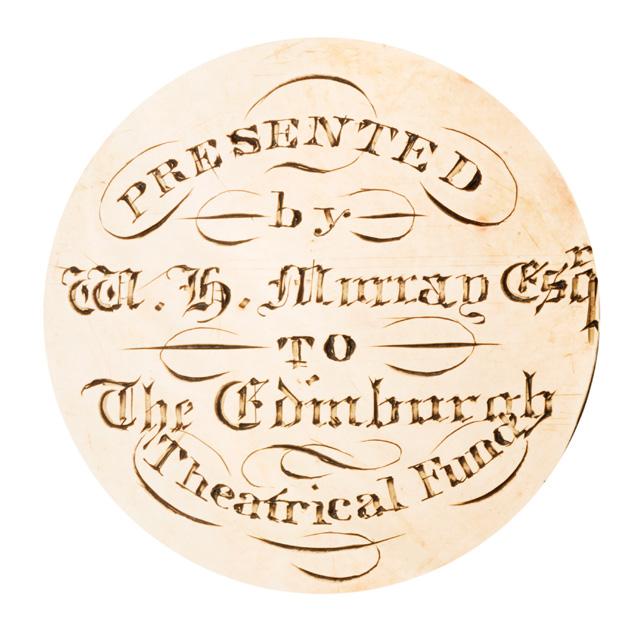

the facetted citrine handle to a gilt metal collar with embossed floral decoration, the rounded rectangular citrine matrix engraved with the arms of clan Kirkpatrick
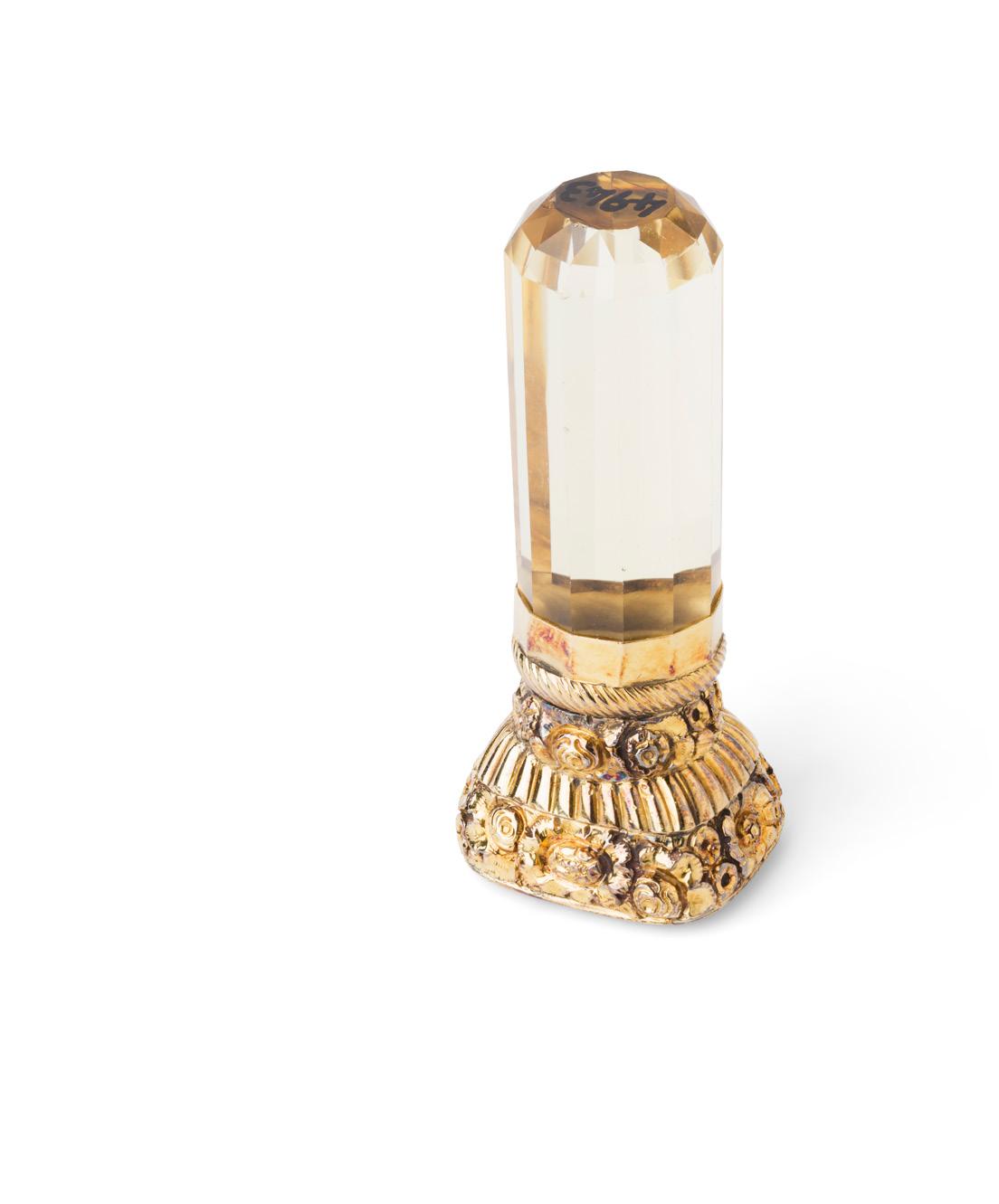
Length: 70mm (overall), matrix: 25mm by 21mm
Heraldry: Arms: Argent on a saltire charged with (……?) and chief azure the last charged with three cushions ermine Crest: A hand couped at the wrist holding a dagger in pale distilling drops of blood proper Motto: I mak sicker [I make sure]
Note: Upon the balance of probability, and without any evidence to the contrary, this seal was at one time in the possession of a gentleman of the Kirkpatrick family. Although it is presently difficult to pinpoint which branch of the family the gentleman belonged, as there are slight variants to charges found in the arms as blazoned above that differ them from chiefly or stem from the family of Kirkpatrick of Closeburn in the County of Dumfriesshire, the following hypothesis might be a credible one. As these armorial bearings do not appear to have been recorded in the Registers of Lyon Court in Edinburgh, an examination of the Books of Ulster King of Arms was undertaken and it was found that similar armorial bearings were confirmed by then Ulster King of Arms, Sir Neville Wilkinson on 20th February 1925 at Dublin Castle. The gentleman who was confirmed in these armorial bearings was the grandson of William Kirkpatrick of Donacomper in the County of Kildare, who was living probably during the early to mid-19th Century. The text of the confirmation from the Ulster King of Arms stated the family descended from a younger branch of the Kirkpatricks of Closeburn aforesaid and that the family had long used these armorial bearings but as they found not to be recorded with the Ulster King of Arms they thought it best that they should be so recorded. So, there is, therefore, a presumption that owing to the closeness of the design of both arms and crest (save for the use of the ‘crown’ on the saltire) as engraved upon the matrix and the confirmed armorial bearings that this seal was at one time in the possession of the family of Kirkpatrick of Donacomper.
The clan takes its name from the church of Saint Patrick in Dumfries and Galloway
£600-900
A FINE VICTORIAN BLOODSTONE AND GOLD DESK SEAL, CIRCA 1843
the facetted baluster bloodstone handle to a gold collar and mount, the bloodstone matrix intaglio carved with full armorial, in original fitted case inscribed to lid for Mortimer and Hunt


Length: 92mm, matrix: 22mm diameter
Heraldry: The arms as engraved upon the matrix are those of the family of Balfour impaling Gascoyne-Cecil. These armorial bearings undoubtedly commemorate the marriage of James Maitland Balfour of Whittingehame in the County of East Lothian and of Strathconan in the County of Rosshire (born 5th January 1820, died 23rd February 1856) and Lady Blanche Mary Harriet Gascoyne-Cecil (born 1825, died 16th May 1872).
£1,000-1,500
A FINE EARLY VICTORIAN SCOTTISH THREE-COLOUR GOLD AND SMOKEY QUARTZ DESK SEAL, CIRCA 1840 the tapered facetted handle with a gold foliate border, above a facetted spherical smoky quartz bead in chased acanthus mounts, the matrix with engraved crest in a domed mount with applied flower heads and foliate borders in vari-coloured gold, in a later fitted case Length: 75mm, matrix 18mm x 16mm


Provenance: David Lavender, London
Note: The crest of a stag’s head erased with a cross ditched between naturals is used by various Scottish families, including Cairns, Crawford of Ayrshire and others. Without a motto, it has not been possible to identify a specific family
£2,000-3,000
A GEORGE IV CORAL, GOLD AND AGATE SEAL, CIRCA 1830
the naturalistic coral branch stem set with twin matrices, the upper mount formed as an eagle’s claw enclosing an oval banded agate seal with script engraving Lathockar, the other outlined with a trailing foliate mount with crest and motto in garter
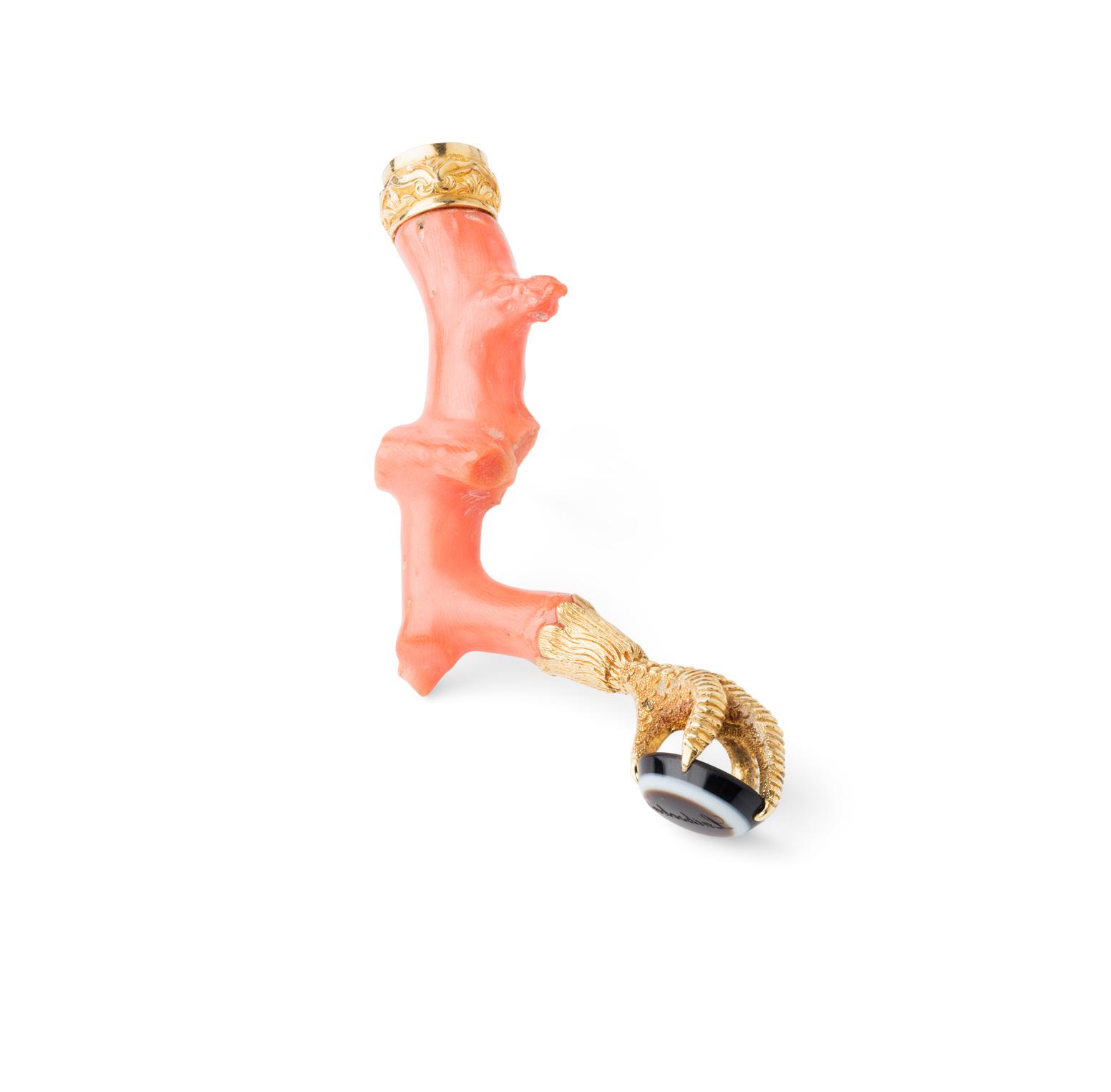
Length: 76mm, matrices diameter: 11mm x 10mm and 7mm
Note: Lathockar House, now a ruin, is three miles from Lathones in Fife Scotland
£400-600
AN EARLY VICTORIAN SILVER AND CARNELIAN FOB SEAL, CIRCA 1845
the simple silver seal mounted in silver with reeded suspension loop, the rectangular carnelian matrix with arms of Scott with Marquis coronet above Length: 25mm, matrix; 14mm x 20mm

Heraldry: The Arms of Scott, Duke of Buccleuch and Queensberry
Arms: Or on a bend azure a mullet of six points between two crescents of the field
The arms appear to be ensigned with a coronet of a marquess/marquis in error whereas it should be the coronet of a Duke. Supporters: Two female figures habited from the waist downwards in blue kirtles gathered up at the knees the arms and bosoms uncovered around the shoulders flowing mantles vert suspended by the exterior hand girdles and sandals gules and their heads adorned with a plume of three ostrich feathers argent
Walter Francis Montagu Douglas Scott, the 5th Duke of Buccleuch and 7th Duke of Queensberry (born 25th November 1806 died 16th April 1884).
Walter was the fifth child of seven, and second son of Charles Montagu-Scott, the 4th Duke of Buccleuch and 6th Duke of Queensberry and his wife, The Honourable Harriet Katherine Townshend, the youngest daughter of Thomas Townshend, the 1st Viscount Sydney and his wife, Elizabeth Powys. Walter when Earl of Dalkeith, he succeeded his father as to the Dukedoms of Buccleuch and Queensberry on the 20th April 1819 when aged thirteen.
He married Lady Charlotte Anne Thynne, the youngest daughter of Thomas Thynne, the 2nd Marquess of Bath and his wife, The Honourable Isabella Elizabeth Byng, the daughter of George Byng, the 4th Viscount Torrington and his wife, Lady Lucy Boyle at the Parish Church of St George, Hanover Square, Westminster in the County of Middlesex on the 13th August 1829. He was educated at Eton College and at St John’s College, Cambridge.
In the House of Lords, the duke sat on the Conservative benches and was appointed as a Member of Her Majesty’s Privy Council in 1842. He served as the Lord Privy Seal from 1842 to 1846 and as the Lord President of the Council from January to July 1846 in Sir Robert Peel’s administration. The duke was appointed the Colonel of the Edinburgh Militia on the 6th January 1842 and he was further appointed an Aide-de-Camp to Queen Victoria for the militia on the 19th March 1857. He was appointed as a Knight of the Garter in 1835.
Walter had also been elected as a Fellow of The Royal Society in June 1883 and became the Chancellor of the University of Glasgow in 1878, an office which he held until his death in 1884. As an aside, the Duke also enjoyed playing cricket so much, that he played in at least two first-class cricket matches for Marylebone Cricket Club.
£150-180
A SCOTTISH HARDSTONE FOB SEAL, ARMS OF HILL OF LAMBHILL, CIRCA 1790

the handle formed of four scrolling arms to a lion mask terminal, the oval chalcedony matrix with armorial and motto VERITAS SUPEROBIT MONTES
Length: 42mm (overall), matrix: 28mm x 24mm
£300-500 28

AN EARLY 18TH-CENTURY STEEL SWIVEL FOB SEAL
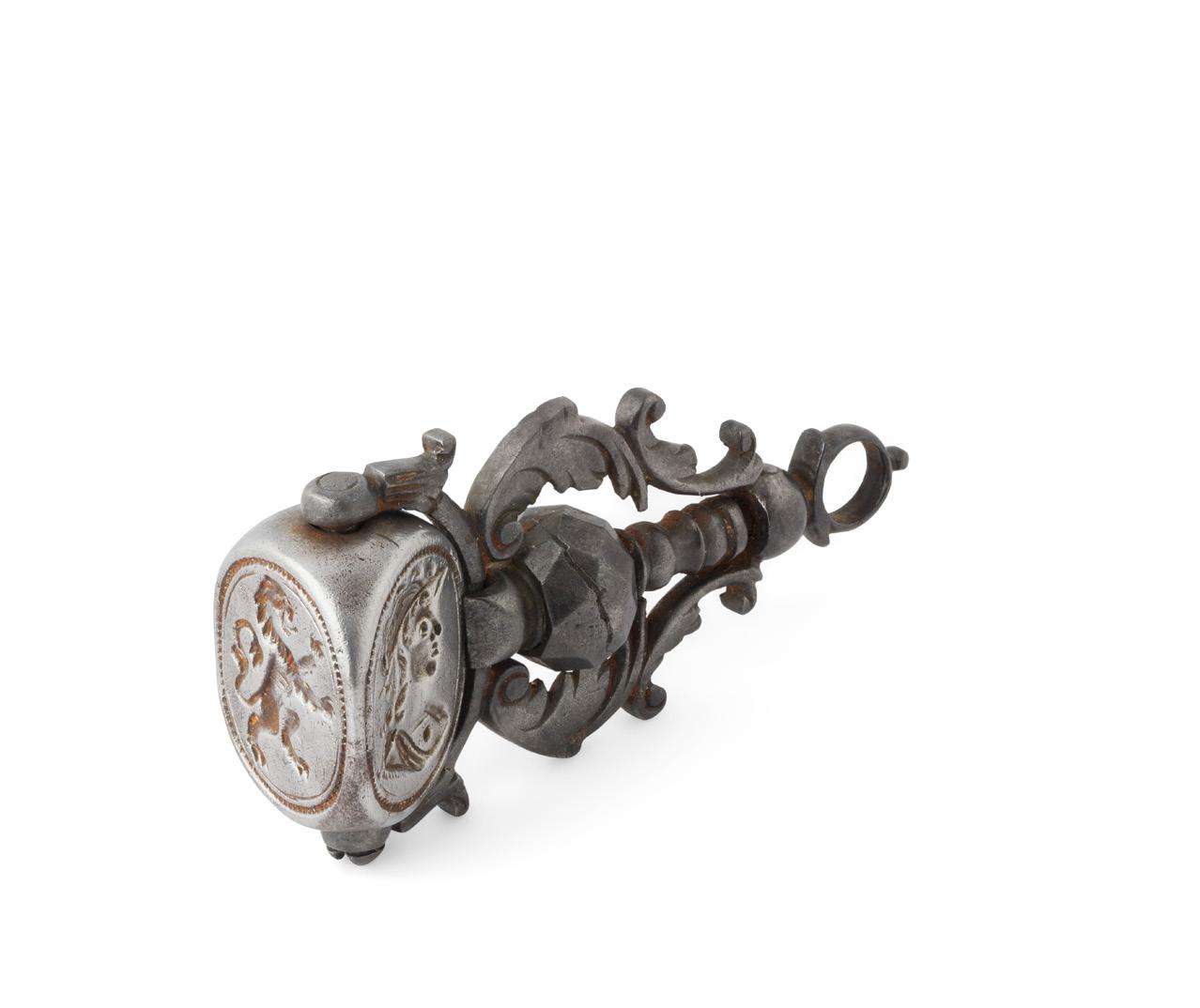
the stem formed of acanthus and scroll detail branches, the triple face with a depiction of a soldier, a rampant lion and a thistle and rose below a crown and UNITED Height: 50mm, matrix: 26mm x 13mm approx
£300-500
A 19TH-CENTURY SILVER-MOUNTED AGATE DESK SEAL
the agate handle of facetted form, to a silver mounted collar with engraved foliate and floral decoration, the agate matrix, of possible Sassanian (6th-2nd BC) origin, of oval outline with an engraved depiction of a stag walking with spread antlers below a crescent moon within a linear border, a probable reference to the Classical mythology Diana the Huntress

Length: 10cm, matrix: 30mm x 26mm
£400-600
THE CLAN MACAULAY SEAL
A MOTHER OF PEARL SEAL MATRIX of oval outline, with armorial engraved to the disc



Matrix: 32mm x 24mm
£80-120 31
AN EARLY 19TH-CENTURY MOTHER OF PEARL AND SILVER DESK SEAL
CIRCA 1830
the mother of pearl handle, likely French or Italian, of flattened form with foliate carved details and pommel, the silver matrix with chased Rococo foliate scrolls, engraved with arms of Stewart quartering Comyn
Length: 89mm, matrix: 22mm x 17mm
Note: The arms are for a cadet branch of the Stewart’s of Garth, Perthshire, Scotland. Originally descended from James illegitimate son of Alexander Stewart, 4th son of King Robert II of Scotland, most commonly recognised as Earl Buchan in 1382, and known as the Wolf of Badenoch
£200-300
THE EARLS OF CRAVEN DESK SEAL
AN UNUSUAL LATE 19TH-CENTURY DOUBLE ENDED PEBBLE DESK SEAL
the oval pebble with polished terminals, each engraved, one end with an Earl’s coronet above a Gothic D, the other end, the Earl’s coronet above a crest
Length: 55mm, diameter of matrices: 14mm x 15mm, 15mm x 12mm
Crest: On a cap of maintenance a dragon passant with an Earl’s coronet above
Note: The polished agate pebble reflects the taste of the Victorian era for the natural resources of the rugged landscape that was fuelled by Queen Victoria’s love of Scotland. This can be seen in high quality pebble jewellery and works of art, but also here in a far more simple and tactile manner.
£200-300
A CROCKETT OF SCOTLAND FAMILY DESK SEAL
A LATE 19TH-CENTURY BANDED AGATE AND BLOODSTONE SEAL
the facetted brown banded agate, of baluster form, to a chased silver mounted collar with four acanthus scroll arms, the bloodstone matrix engraved with the crest and motto HAVE A CARE, presented in a fitted case, the base stamped for ‘BURGER-LEVEQUE/ Graveur/ 64 PALAIS ROYAL 3
Length: 81mm, matrix: 22mm x 17mm
Note: Attributed to a branch of the Scottish family Crockett, who use a variety of mottos including TAK’TENT, TAKE HEED, TAKE CARE, in connection with either a sleeping or walking hound. A Chinese export armorial porcelain dinner service with the motto TAKE HEED with a hound crest made in circa 1785 is recorded for the family
£600-900
AN EARLY VICTORIAN BANDED AGATE GOLD AND BLOODSTONE DESK SEAL, CIRCA 1850
the banded agate handle with domed terminal and facetted stems, the compressed fluted gold terminal enclosing a rounded rectangular matrix engraved Glenavon



Length: 70mm, matrix: 19mm x 22mm
£300-500
THE TENNANT OF GLENCONNER FAMILY DESK SEAL
A LATE 19TH-CENTURY AGATE DESK SEAL,CIRCA 1890S
the facetted agate handle, the integral matrix engraved with the crest and motto ‘Deus Dabit Vela’
Length: 65mm (overall), matrix: 35mm x 27mm
£200-300
THE LANCASTER FAMILY SEAL
A VICTORIAN BANDED AGATE DESK SEAL, CIRCA EARLY 20TH CENTURY the banded agate seal with facetted tapered handle with waisted neck, the oval matrix with armorial shield surmounted by crest with motto in banner below

Length: 70mm, matrix: 24mm x 20mm
Heraldry: Arms: Argent two bars gules on a canton of the second a cinquefoil (……?)
Crest: A lion couchant (……?)
Motto: Ornat fortem prudentia [Prudence adorns the brave]
Upon the balance of probability and without any evidence to the contrary this seal was at one time in the possession of a gentleman of the Lancaster family.
£200-300
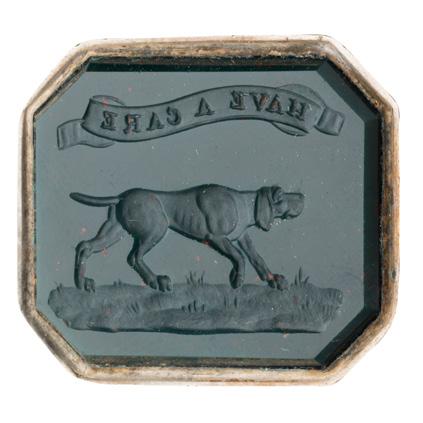
A VISCOUNT’S AGATE AND GOLD MOUNTED DESK SEAL, CIRCA 1840S
the agate handle with domed terminal and of tapering form, within a fretted collar with phoenix birds and scroll-work decoration, the escutcheon-shaped matrix engraved with a Viscount’s coronet above a cypher of two Ms
Height: 76mm, matrix: 23mm x 15mm
£1,000-1,500 38
THE JUCKES FAMILY DESK SEAL
A MID / LATE 19TH-CENTURY BANDED AGATE DESK SEAL

the facetted banded brown agate handle of baluster form, double ended with the engraved coat of arms to the base and the crest to the top

Length: 67mm, matrices: 18mm x 14mm, 22mm x 20mm
Note: The family of Juckes with these arms is recorded as quartering the arms of Clifton (not shown on this shield) for which family a baronetcy was created in 1611.
The 8th Baronet, Sir Juckes-Granville Clifton, assumed the additional surname of Juckes died in 1852; the baronetcy became extinct with the death of his son in 1869. This seal would have been made for a close relative (although not a Clifton descendant)

£150-250
39
A SCOTLAND AND ENGLAND UNION-ASSOCIATED DESK SEAL
AN 18TH-CENTURY PURPURINE DESK SEAL
the facetted glass handle with gold mounted button terminal with pierced initials M/A/M/A, the applied collar with pierced thistles and roses, to a green hardstone seal with engraved armorial

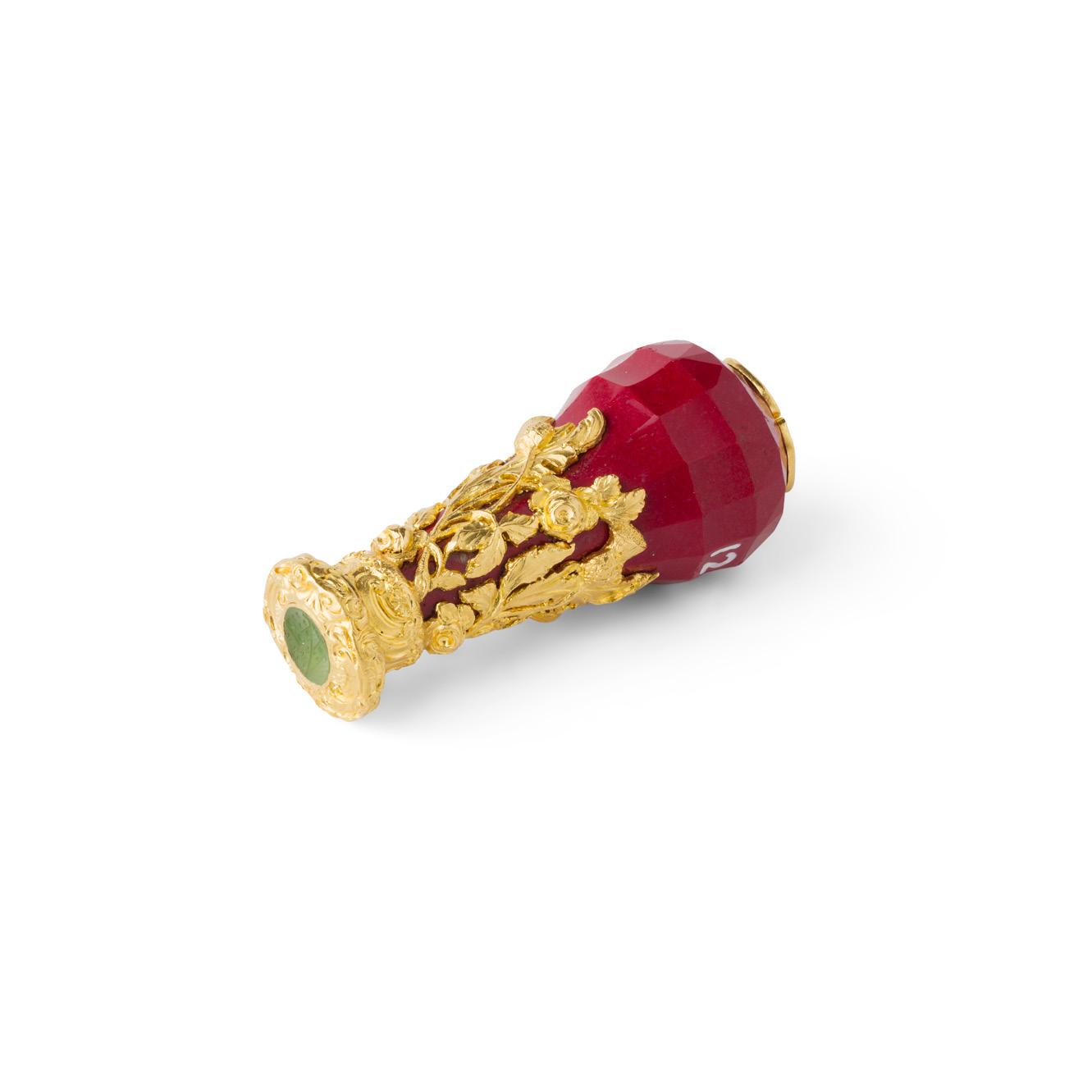
Length: 50mm, matrix: 6mm x 8mm
£800-1,200
THE SEATON HOUSE SEAL
A VICTORIAN SCOTTISH AGATE AND GOLD DESK SEAL
the facetted red banded agate baluster handle with foliate scroll terminals enclosing a black banded agate matrix engraved Seaton House Arbroath
Length: 65mm, matrix: 12mm x 10mm
£250-350
41
A SCOTTISH MATHIESON FAMILY DESK SEAL
AN EDWARDIAN SILVER GILT AND HARDSTONE SEAL, BY GEORGE PAUL, EDINBURGH 1908
the tapered silver-gilt handle profusely engraved with scroll and foliate detail, collet set with various gemstones to the terminal and inset with diamond-shaped hardstones to the stem, to a domed collar, the silver-gilt matrix with engraved crest
Length: 85mm, matrix: 21mm x 19mm
Note: Believed to be the personal seal of the 2nd Baron Mathieson


£300-500
THE MORISON OF DAIRSIE CO. FIFE FAMILY DESK SEAL
AN EARLY VICTORIAN AGATE DESK SEAL
the facetted agate handle to a gold fluted collar with shell and floral borders, the rounded rectangular chalcedony matrix engraved with armorial


Length: 80mm, matrix: 21mm x 23mm
£1,200-1,800
A FAMILY DESK SEAL - CRIMONMOGATE HOUSE, BUCHAN ABERDEENSHIRE
A LATE 18TH-CENTURY WOODEN AND BRASS DESK SEAL

the wooden handle of baluster form, to a brass collar and matrix, engraved with armorial and legend in a border Length: 9cm, matrix diameter: 12mm

£300-500 44
A LATE 18TH-CENTURY EBONY AND STEEL DESK SEAL
the turned tapered ebony handle with socket attached, oval steel matrix with crest and motto for Murray
Length: 95mm, matrix: 18mm x 8mm
£120-180
45 Y
A VICTORIAN BOG OAK, IVORY AND BRASS DESK SEAL, CIRCA 1870
the carved wooden handle formed as a lady’s head with hood, the face formed from carved ivory, the simple brass socket set with shield-shaped matrix with armorial and motto

Length: 96mm, matrix 37mm x 30mm
Note: Although the arms in this format are not officially recorded, it would appear to be a slightly altered arms of a branch of the Crierie, Kriery or M’Crie of Scotland
With non-transferable CITES selfcertification number: B3RECNKV £250-350

A VICTORIAN LABURNUM, SILVER AND AGATE DESK SEAL, CIRCA 1870S
the laburnum handle of baluster form, to a simple threaded silver mounted collar, the oval matrix with the arms of Menzies
Length: 95mm, matrix: 26mm by 24mm
Note: Given the suspected age of this seal, it was probably in the possession of two successive chiefs of the clan Menzies, namely Sir Robert Menzies in the county of Perthshire (1817 to 1903), the seventh Baronet of Menzies or his son, Sir Neal James Menzies, the eight and last Baronet of Menzies (1855 to 1911)

The baronetcy fell into extinction on his death for want of a male heir. The clan is said to have descended from a mythical ‘Scottish’ King Mainus of 33BC, but is perhaps ill-founded and the clan arrived in Scotland following the 12th century Norman arrival and are descended from Robert de Maineriis of Mesnieres near Rouen in Normandy.
The first chief was Sir Robert de Meyneris, who became Chamberlain to King Alexander II in 1249 and received lands in exchange for his military service. It was in 1488 that his descendant Sir Robert Menzies built ‘The Place of Weem’, and maintained their stronghold in Strathtay for over four hundred years. They managed to maintain their standing and possessions until the estates, the Castle, and its contents were auctioned off to pay outstanding debts in 1914. With the extinction of the main line the Clan was left without a Chief on the death of Sir Neil Menzies in 1910.
In 1957 the descendants of the cousin of the first Baronet were successful in petitioning Lord Lyon King of Arms to be recognised as being allowed to use the arms of Menzies. The current Chief is Captain David Steuart Menzies of Menzies.
£500-800
47
THE CHISHOLM SILVER DESK SEAL

A LARGE MID-VICTORIAN SILVER DESK SEAL, CIRCA 1870 the naturalistic vine leaves trailing around an architectural column forming the handle, the domed integral matrix with scroll foliate mount, the matrix engraved with arms and supporters
Length: 75mm, matrix: 45mm diameter
Heraldry: Arms: Gules a boar’s head erased argent Crest: A dexter hand holding a dagger erect proper on the point a boar’s head couped gules
Supporters: Two savages wreathed head and middle with laurel with clubs over their shoulders proper
Mottos: (above the crest) Feros ferio [I strike the fierce] (below the arms) Vi aut virtute [By strength and valour]
£800-1,200
A SCOTT-TOLLEMACHE FAMILY DESK SEAL
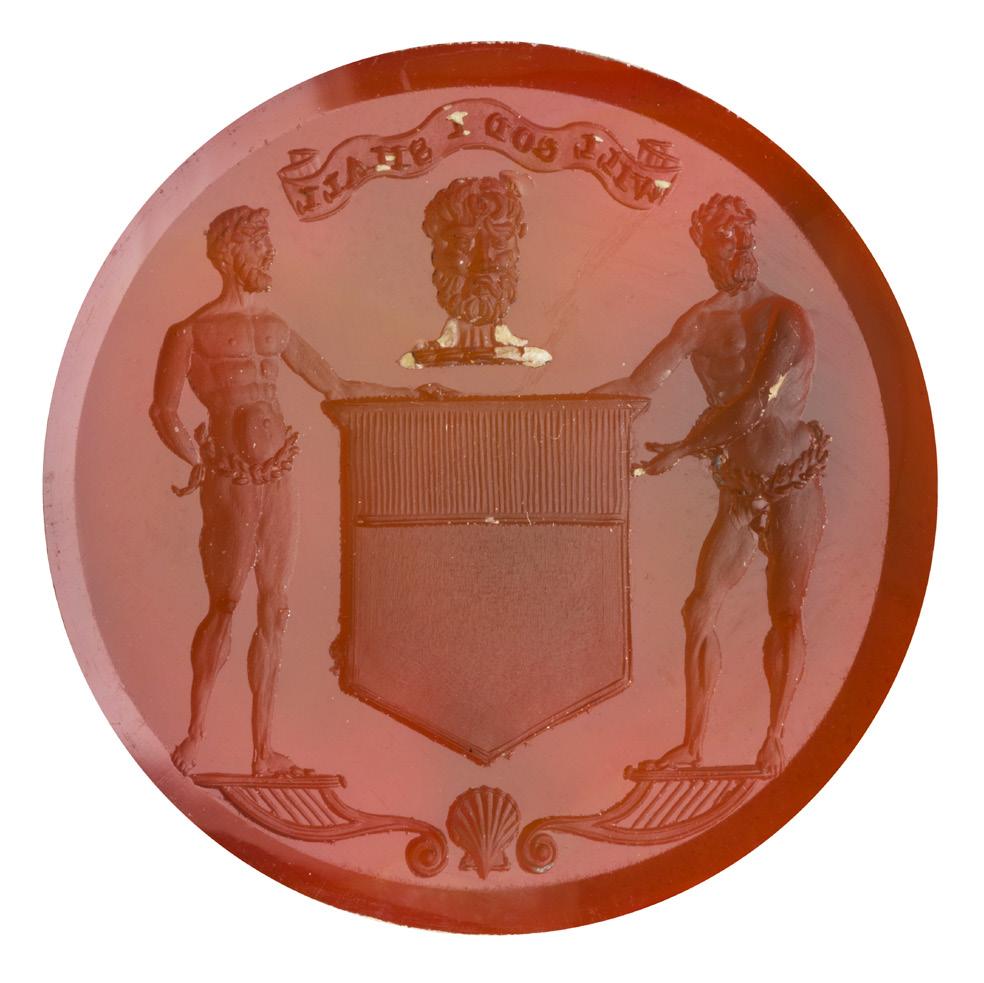
A MID / LATE 19TH-CENTURY SILVER-GILT DESK SEAL
the flared cast handle with high-relief depictions of soldiers in battle with a rope twist border, the circular matrix engraved with the arms of Scott impaling Tollemache
Length: 77mm, matrix diameter: 20mm
Provenance: Matrix: A Collection of British Seals - David Morris 2012
- Seal 28, page 72
Note: The seal was made for Charles Norman Lindsay Tollemache Scott, JP for the Stewartry of Kirkcudbright and JP for Leicestershire
Born in 1853, the eldest son of John Lindsay Scott of Mollance, he married in 1882, Lady Agnes Tollemache, daughter of the 8th Earl of Dysart. Their only daughter, Wenefryde Agatha succeeded her uncle, the 9th Earl of Dysart as Countess Dysart in her own right in 1935, it being a Scottish title and heritable in females. The baronetcy and the entailed estates went to a cousin, Sir Lyonel Tollemache.
£1,200-1,800
A MACLAGAN FAMILY DESK SEAL


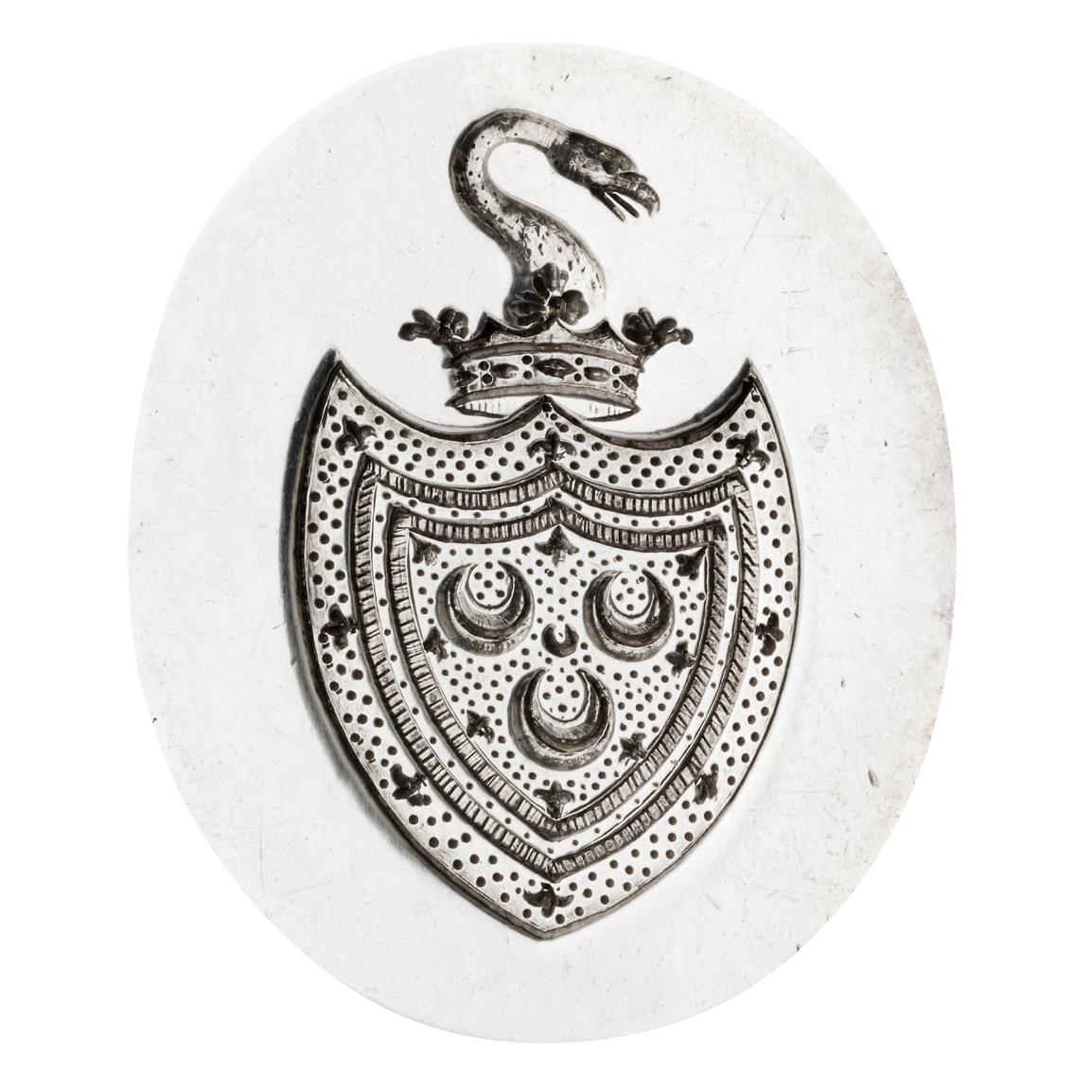
AN EARLY 19TH-CENTURY TREEN AND SILVER MOUNTED DESK SEAL
the wooden handle formed as an arm clutching a boot in its hand, to a silver collar and matrix, the circular matrix with engraved crest and motto
Length: 7cm, matrix diameter: 22mm
Heraldry: Crest: Out of ducal coronet, an ounce or beaver’s head proper Motto: PRINCIPIIS OBST
The motto is recorded for three families, of whom only one uses a similar crest, Maclagan of Edinburgh
£120-180
50
THE GLENAY FAMILY DESK SEAL
AN EARLY 18TH-CENTURY EBONY DESK SEAL
the flared ebony handle to a silver mount with threaded collar, the armorials engraved to terminal
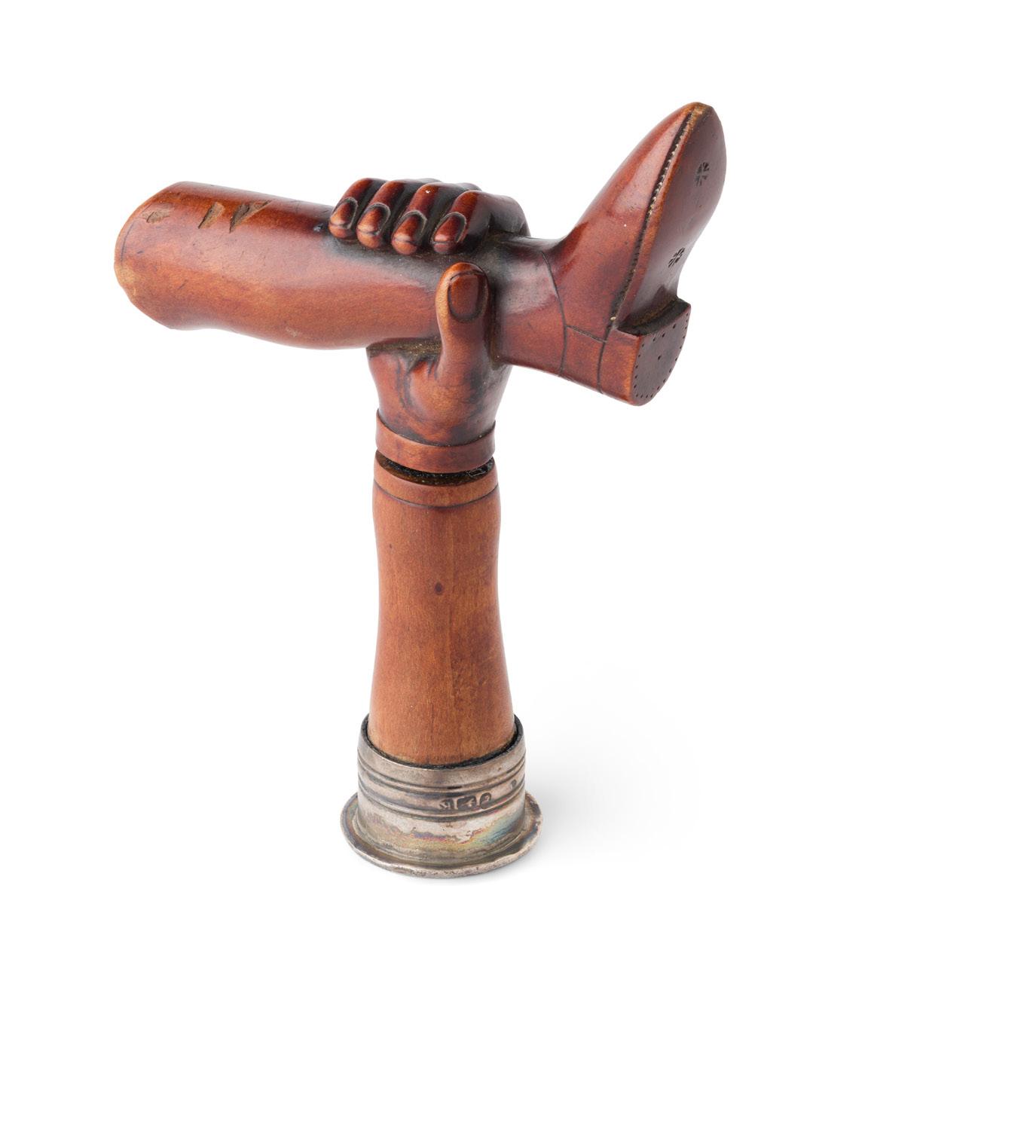
Length: 85mm, matrix: 22mm x 25mm
£400-600
51 Y
THE EDMONSTONE FAMILY DESK SEAL
A SILVER MOUNTED TOOTH DESK SEAL, BY ASPREY & CO, LONDON 1930 the tooth with an applied silver collar, with pierced sides, the integral oval seal with an engraved crest above a heraldic shield, engraved to the sides
NGAMILAND 15 SEPT 1929
Length: 10cm, matrix: 30mm x 25mm
Note: CITES STATUS: African Lion Panthera leo - CITES Appendix II - Annex B (Added 02/01/2017) [Only the populations of India are CITES Appendix I (26/11/2019); all other populations are included in Appendix II] - Article 10 Exempt as a worked specimen in a finished state before 3 March 1947
This specimen has been carved and fitted inside this desk seal that is clearly hallmarked and dated to 1929 with the location of Ngamiland (a North-West district area of Botswana). The only big cat species large enough for this specimen to have come from is either a lion or a tiger. All species of tiger’s population range were on another continent from Ngamiland in the 1920s as were all populations of the Asiatic Lion, therefore this specimen could only have come from an African Lion. Following the CoP17 summit in Johannesburg in 2017 the trade in lion parts including bones, skins, teeth to trophy heads were banned from current wild populations but historic specimens appear to still be subject to the same jurisdiction as other specimens from Appendix II species. An Article 10 Certificate is not required to own or trade in specimens of species listed on Annex B of the CITES regulations.
£300-600
THE ADMIRAL SIR WILLIAM EDMONSTONE, 4TH BARONET CB, DL (1810 – 1888) SEAL
A 19TH-CENTURY ROCK CRYSTAL AND BLOODSTONE DESK SEAL

the facetted rock crystal handle of tapering form, to an ornately chased scroll and floral collar, the rounded rectangular bloodstone matrix with the arms of Edmonstone
Height: 8.5cm, matrix: 19mm x 15mm

Heraldry: Creation 20 May 1774
Arms: Or three crescents, within a doublet treasure, flory-counterflory gules
Crest: Out of a ducal coronet, or a swan’s head and neck
Supporters: Two lions, rampant
Motto: Virtus auget honorem
Note: Admiral Sir William Edmonstone, 4th Baronet CB, DL (29 January 1810 – 18 February 1888)
Beginning his naval service in his youth, on his return from West Africa he was made an Aide-de-Camp to Queen Victoria and appointed a Companion of the Order of the Bath.
Following his retirement from the navy, he was elected Member of Parliament for Stirlingshire from 1874 to 1880. During this time he stayed at the family seat, Duntreath Castle, Blanefield, Stirlingshire. Other residences include Colzium near Kilsyth, London, and an Edinburgh town house.
Together with his wife Mary Elizabeth Parsons whom he married in Greece, they had eleven children, their youngest daughter Alice Keppel was the mistress of Edward VII.
Succeeded by his son Sir Archibald Edmonstone, 15th of Duntreath and 5th Bt.C.V.O. D.L., Groom in Waiting to H.M. King Edward VII 1907-10. He accompanied the King on his state visit to Leningrad in 1908. A chromolithograph, published in Vanity Fair, on 8th March 1879 by Sir Leslie Ward of Sir William is now in the collection of the National Portrait gallery accession number NPG D43893
£1,500-2,500
THE STEUART OF DALGUISE DESK SEAL

A FINE EARLY VICTORIAN CITRINE, AMETHYST AND GOLD DESK SEAL, CIRCA 1840

the tapered facetted handle with flat top section engraved with the crest of demi-lion rampant and motto HINC ORIOR in banner above, the lower section of handle with a chased coiled snake above a facetted amethyst knop, the main blank matrix in deeply chased floral mount and with arched supports
Length: 80mm, matrices: 11mm x10mm and 26mm x 20mm
Note: The crest and motto are those of Steuart of Dalguise, Perthshire. The family was descended from Sir John Stewart of Arntullie and Cardneys, and designed of Dowallie, the youngest natural son of Robert II, King of Scotland, and Marion or Mariota, daughter of John de Cardney of that ilk, and sister Robert de Cardney, bishop of Dunkeld, 1396-1436. the crest and motto can be seen in the files incorporated in the coat of arms used as the bookplate of David Steuart (1747-1824), 5th son of John Steuart of Dalguise, and later bibliophile and Lord Provost of Edinburgh.
£1,500-2,500
THE LADY MARY HAMILTON (NÉE MONTAGU), 12TH DUCHESS OF HAMILTON (18541934) DESK SEAL

A FINE VICTORIAN SILVER GILT, BLOODSTONE AND AGATE
FIGURAL SEAL, CIRCA 1875
the cast chased and engraved handle formed as a mailed gauntlet with scrolled cuff, the gripped hand holding a small pommel-shaped seal with fluted octagonal banded agate matrix, engraved with a ducal coronet with Mary below, the upper handle area of polished bloodstone with an arched pommel mount enclosing an oval banded agate matrix engraved ‘BRODICK CASTLE’, the whole contained in a fitted case with indistinguishable maker’s name to silk interior (possible Garrard)

Length: 10cm, matrices: 15mm x 15mm and 19mm x 24mm
£1,500-2,500
Note: Lady Mary Hamilton (née Montagu), 12th Duchess Of Hamilton (1854-1934)
Born at Kimbolton Castle in Huntingdonshire to the 7th Duke of Manchester, Lady Mary married William Alexander Louis Stephen DouglasHamilton, 12th Duke of Hamilton (1845-1895) on 10 December 1873 and moved on the isle of Arran off the west coast of Scotland to Brodick Castle.
Originally a hunting lodge, dating back to the 13th century, Brodick was one of three fortresses/ castles on the island. It wasn’t until the 11 Duke of Hamilton in the 19th century that the family made Brodick Castle a primary residence with major renovations in 1844, almost tripling the size of the building, under the architect James Gillespie Graham.
Now under the care of the National Trust for Scotland, Brodick Castle has a wealth of family heirlooms in the house. Particularly interesting is a collection of mounted hardstones and porcelains that were collected by William Beckford. The Beckford Collection came to Brodick through Beckford’s youngest daughter, Susan Euphemia (1786-1859) as they had a better relationship than her elder sister. Susan Euphemia became the wife of Alexander, 10th Duke of Hamilton (1767-1852). She inherited much of the Beckford Collection and by descent the Collection passed to William, 12th Duke of Hamilton (d. 1895).
Lady Mary Hamilton would have therefore experienced the collection. Her admiration for history can be seen in a portrait of her dressed as
Mary Hamilton, a lady in waiting to Mary Queen of Scots. Now housed in the National Portrait Gallery accession number NPG Ax41207. Together, Mary and William had one daughter named Mary (1884-1957) who married the Duke of Montrose, cementing a fruitful alliance with another aristocratic landowning family in Scotland.
As they had no male heir, the family estates passed to a male cousin, but provisions were made their daughter, Lady Mary, and her father ensured that Brodick Castle was left to her where it continued to be an important family home right up until the 20th century.

A LATE 19TH-CENTURY ROCK CRYSTAL AND MULTI-GEM SET DESK SEAL
the facetted tapered rock crystal handle with engraved M and earl’s coronet engraved to terminal, the applied metal mount formed as an earl’s coronet with pearl spikes, a set border of diamonds alternating with emeralds, rubies and sapphires, the neck with a rope twist border above a pierced border, the rock crystal matrix engraved with the arms for Furst Festetics von Tolna (1850-1933) and Lady Mary Douglas Hamilton

Length: 95mm, matrix diameter: 21mm
Note: This seal was to commemorate the marriage of Lady Mary-Victoria Douglas-Hamilton (1850-1922) and Tasziló II Festetics de Tolna (born Festetics), Prince, (1850 – 1933).
Born to the 11th Duke of Hamilton and Marie Amelie
Elisabeth Karoline Prinzessin von Baden, Lady MaryVictoria was the youngest of three, with two elder brothers. The eldest brother who would go on to become the 12th Duke and marry Lady Mary Montagu.
Lady Mary Victoria’s first marriage was to Prince Albert, the heir apparent of Monaco. The Grimaldi family looked for an alliance with British royalty and aristocracy and the Douglas-Hamilton family was suggested as the highestranking peer in Scotland. Their marriage in 1869 followed quickly with a son, Louis who would become Louis II and grandfather of Prince Rainier III. However, after a couple of years Lady Mary grew to dislike Monaco and their marriage was finally annulled in January 1880 which allowed the marriage to Tasziló II Festetics a Hungarian count in June of 1880.
Following their wedding in Florence they set up home in Budapest with four children, their eldest Maria would marry into the Von Furstenburg family. As Lady MaryVictoria’s mother was Princess Marie of Baden Baden there had always been a strong German connection. Prince Louis had been with his mother for his formative years but was obliged to return for Royal training at the age of 11. It would seem that he also did not enjoy living with his father and left for studies at the Saint-Cyr Military Academy and then onto the Foreign Legion.
The delicate nature of this seal reflects the true love story of Lady Mary-Victoria and Tasziló, purported to be a wedding gift from Tassilo’s sister and brother-in-law, Gina and Zdenko which accounts for the intertwined Ms to the top of the seal.

Lady Mary-Victoria passed away in 1922 and Tasziló ten years later, but they are both buried together on the Festetics estate.
£1,000-1,500
A CARNELIAN DESK SEAL, CIRCA 1840

the hardstone handle of baluster outline, to a simple silver mounted collar, the oval carnelian matrix with engraved crest, possibly for Napier of Merchistoun
Length: 83mm, 22mm x 17mm
Note: Francis, 10th Lord Napier and 13th Laird of Merchistoun was born in 1819 and inherited the title and the Merchiston estate from his father in 1843 of which this seal may be to commemorate. Merchiston Castle itself had been leased out to the Governors of George Watson’s hospital in 1729 so the family never lived there. Due to a successful diplomatic career, he was rewarded with Baron of the United Kingdom and the title of Ettrick in 1872. Following his marriage to Anne Lockwood in Florence in 1845, they had four children. He died in Florence in 1898.
£250-350
THE GENERAL TERMINUS AND GLASGOW HARBOUR RAILWAY DESK SEAL
A TULIP WOOD AND BRASS DESK SEAL, CIRCA 1849 the wooden handle of baluster form with a flat topped terminal, to a brass matrix, engraved ‘0-4-2 tender engine’ above an inscription encircling a threemasted schooner

Length: 96mm, matrix: 24mm x 18mm
Provenance: Sheffield Railwayana Auctions 18th September 1999, lot 351
Matrix: A Collection of British Seals - David Morris 2012 - Seal 121, page 232
Note: The General Terminus and Glasgow Harbour Railway operated a line, and branches from the Pollock and Govan Railway to the River Clyde and opened in 1849. It was amalgamated with the Caledonian Railway in 1865 £300-500
THE GLASGOW & SOUTH WESTERN RAILWAY COMPANY SEAL MATRIX
A VICTORIAN STEEL SEAL MATRIX, 1850
the large steel matrix engraved with crest and dated 1850, with motto THE CORPORATE SEAL OF THE GLASGOW & SOUTH WESTERN RAILWAY
COMPANY, with a short stem
Length: 40mm, matrix: 44mm diameter
Provenance: Sheffield Railway Auctions, 11th December 1999 lot 352
Note: The Glasgow & Southwestern Railway, which served a triangular section of south west Scotland, including Ayrshire and the busy Firth of Clyde ports, was formed by the amalgamation of the Glasgow, Dumfries & Carlisle Railway, and the Glasgow, Paisley, Kilmarnock & Ayr Railway in 1850. The new railway adopted the emblem previously used by the latter company
£100-200
A PARLIAMENTARY SEAL FOR THE GENERAL TERMINUS AND GLASGOW HARBOUR RAILWAY 1846
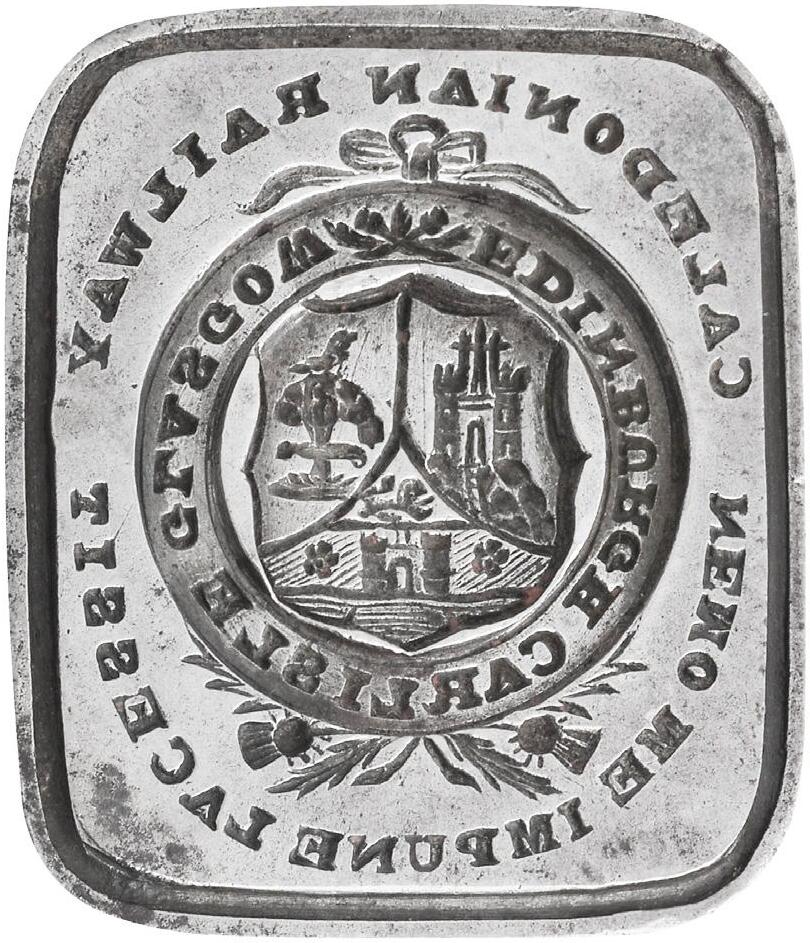
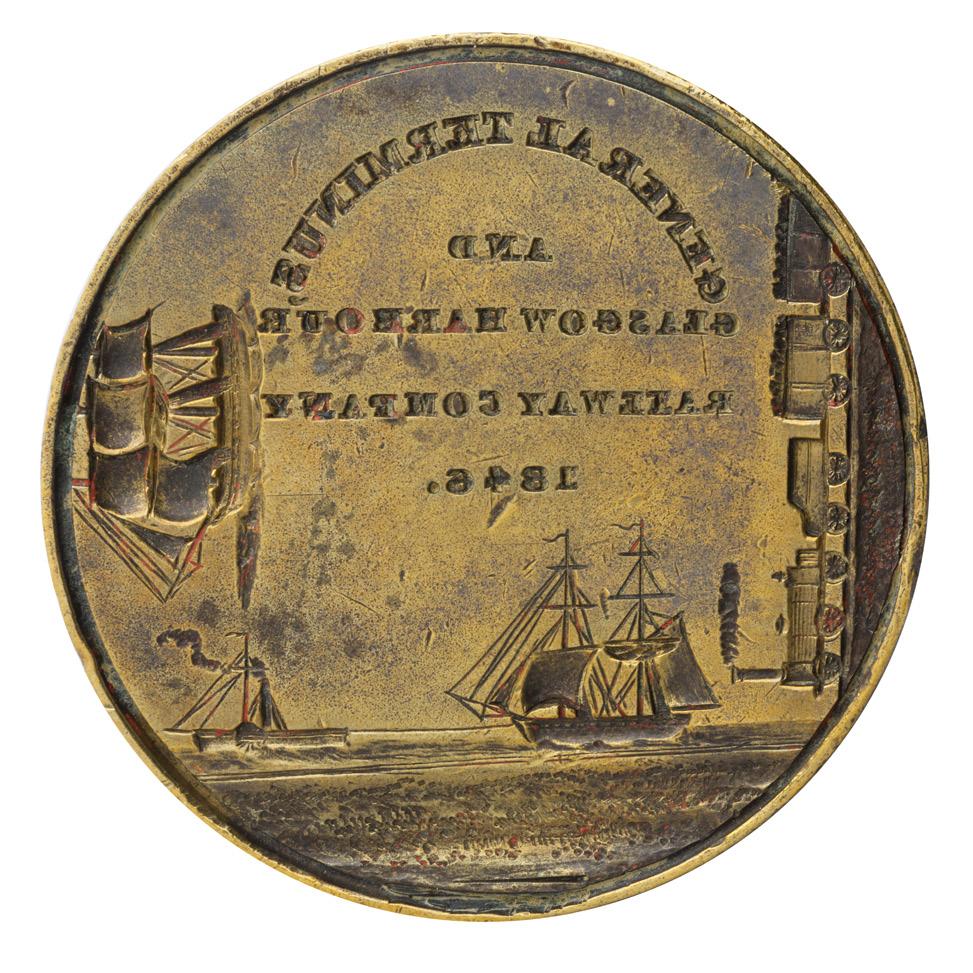

A MID-19TH-CENTURY WOODEN AND BRASS DESK SEAL
the turned wooden handle of baluster form, to a brass collar, the integral matrix with engraved transport depictions and ‘GENERAL TERMINUS AND GLASGOW HARBOUR RAILWAY COMPANY 1846’
Length: 91mm, matrix diameter: 38mm
Provenance: Lot 145 Great Central Railwayana Auctions, 13th October 2012
Note: The General Terminus and Glasgow harbour railway was authorised in 1846, opening in part by the end of 1848, its main function was to be the transportation of the booming collieries from Lanarkshire and Ayrshire, depositing the coal for further transport on the south bank of River Clyde. It also had an instrumental use in linking already established railway lines together, these included Pollock and Govan, Glasgow and Paisley joint railway, and Kilmarnock and Ayr railway, as well as those using the Clydesdale junction railway. The line would continue until 1854 when parts of it were amalgamated with the Caledonian railway and a final amalgamation would take place in 1865.
£400-600
AN EARLY 19TH-CENTURY WOODEN AND STEEL DESK SEAL, CIRCA 1865 the turned hardwood handle with reeded lower section to a square steel matrix, engraved with armorial with garter and inscribed EDINBURGH CARLISLE GLASGOW, the whole surmounted by Caledonian Railway and motto Nemo Me Impune Lacasset below
Length: 93mm, matrix: 23mm x 20mm
Provenance: Great Central Railway Auctions, 13th October 2012, lot 222
Note: The Caledonian Railway, which acted as the first continuous travel between Glasgow and London, was formed in 1845 with the objective of connecting Glasgow with the English railways. The Caledonian railway evolved from English concerns of linking cities through rail travel, their main line which opened in 1848 positioned the Caledonian Railway at the peak of Scottish rail companies. Due to the Railways Act of 1921 the Caledonian Railway became a constituent of the newly formed London, Midland and Scottish Railway, formed in 1923.
In 1865 they adopted a version of the Scottish arms as their crest, later adding a further ribbon below their motto bearing the words Caledonian Railway Company The motto translates to No one provokes me with impunity and derives from the Royal Stuart dynasty.
£300-500
THE GENERAL MANAGER OF THE CALEDONIAN RAILWAY SEAL MATRIX
A MID / LATE 19TH-CENTURY STEEL SEAL MATRIX, CIRCA 1865

the cylindrical matrix with a short stem, engraved to edge, TOP, the matrix engraved with the pre-union Scottish Royal arms and motto CALEDONIAN RAILWAY around Length: 26mm, matrix: 28mm diameter
Provenance: Sheffield Railway Auctions, 11th December 1999 lot 353
Note: The Caledonian Railway was the first line to link Glasgow with England via Carlisle from 1849 and the company rapidly expanded, taking over many smaller rival lines. Of its General Managers, perhaps the best known is the last, Donald Matheson, who was not only General Manager of Caledonian from 1910-1922 but oversaw its incorporation into the London, Midland and Scottish Railway, becoming General Manager of the new company until his retirement in 1926. It was he also who conceived the idea of creating the Gleneagles golf courses and grand hotel.
The Caledonian Railway’s adoption of the pre-Union Scottish arms as its emblem was unofficial and not authorised by the Lord Lyon King of Arms
£100-200
THE WISHAW & COLTNESS RAILWAY COMPANY SEAL


A GEORGE IV / EARLY VICTORIAN LABURNUM AND STEEL SEAL, CIRCA 1840
the slender baluster handle of polished laburnum, with simple circular steel seal engraved with motto Wishaw & Coltness Railway Company around a scene of an engine pulling carts over a bridge
Length: 10.2cm, matrix diameter: 27mm
Provenance: Great Central Railway Auctions, 13th October 2012, lot 307
Note: The Wishaw & Coltness Railway Company was one of the earliest railway companies formed in Scotland. It was formed by act of parliament in 1829 to raise £80,000 on an estimate of £50,000 in construction costs. Shortages of funds led to further Acts and was funded in the end to a much higher level than expected. The company operated over an 11-mile route from Chapel Colliery at Coltness to join the Monkland and Kirkintilloch Railway. Originally built to a Scotch gauge of 4ft 6 inches as a single track line engineered by Thomas Grainger. By 1849 it was to become part of the larger Caledonian Railway and is now part of the West Coast Main Line
£300-500
63
THE MOFFAT RAILWAY COMPANY DESK SEAL
A LATE 19TH-CENTURY STEEL DESK SEAL, CIRCA 1881
the circular disc engraved a central crest and motto within the legend in a border, with pierced spigot to reverse
Diameter of matrix: 41mm
Provenance: Sheffield Railway Auctions, 11th December 1999, lot 351
Note: The construction of a single-track branch line from Moffat to Beattock, which was situated on the main line between Carlisle and Glasgow, by the Moffat railway Company, authorised in 1881 and the line opened in 1883.
It was leased to the Caledonian Railway in 1884 and taken over completely in 1889.
The town of Moffat had no armorial bearings so displayed the Johnstone crest of a winged spur and the motto: Nunquam non apparatus (never unready). Moffat had been created a Burgh of Regality in favour of James Johnstone of Corhead in 1684 and this was confirmed to James Johnstone, 3rd Earl of Annandale in 1662
£150-180
64
THE TRUSTEES OF THE HARBOUR OF INVERNESS DESK SEAL
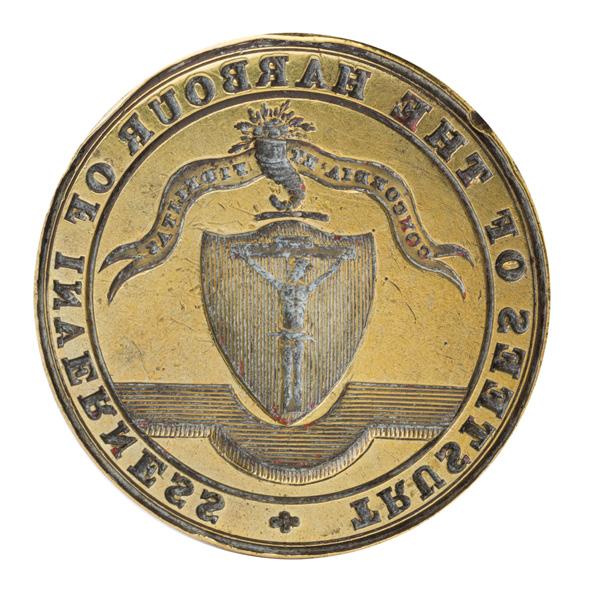
A VICTORIAN WOODEN AND BRASS DESK SEAL, CIRCA 1850
the cylindrical wood to a brass disc, engraved with the coat of arms for Inverness in a border of the legend
Length: 50mm, matrix diameter: 39mm
Note: The Port of Inverness is operated as a Trust Port under the control of Inverness Harbour Trust which was constituted by an Act of Parliament in 1847. The port’s historic records go all the way back to 1249. The port traded with Scandinavia and the rest of the United Kingdom, shipping many natural resources from the fertile highlands.
£400-600
THE COMPANY OF PROPRIETORS OF THE FORTH & CLYDE CANAL NAVIGATION DESK SEAL
A LATE 18TH-CENTURY BRASS DESK SEAL, CIRCA 1770
the circular brass disc engraved with a depiction of a Classical figure and Royal banner for Scotland, with the canal in the background and a cornucopia in the forefront, within an engraved border

Diameter: 44mm
Provenance: Matrix: A Collection of British Seals - David Morris 2012 - Seal 114, page 220
Note: The Forth & Clyde Canal Company, which by act of parliament was incorporated as the Company of Proprietors of the Forth and Clyde Navigators in 1768, were responsible for the construction of a canal route between the Firth of Forth and the Firth of Clyde, allowing navigation from Edinburgh to Glasgow. The Canal was very successful and tested trials for steamboats towards the end of the 18th century, hosting the first practical steamboat, the Charlotte Dundas. It was acquired by the Caledonian Railway in 1842 and later closed in 1960.
£400-600
THE BANFF LITERARY SOCIETY SEAL
AN EARLY 19TH-CENTURY LABURNUM AND BRASS SEAL, CIRCA 1810

the turned laburnum baluster handle socket mounted to an oval brass matrix, engraved with a bee skep within flowers and trees with motto ALVEUM ACCIPITE SOC:LIT:BANFF around
Length: 92mm, matrix: 39mm x 32mm
Note: Banff is a town in Aberdeenshire. The Banff Literary Society was instituted by five local youths in 1810, and the purpose of the society was to form a library and to hold meetings where essays could be read aloud, and literary topics could be discussed. The library held an extensive collection of technical literature on farming and practical philosophy of the highest intellectual content, amongst a plethora of other literature. The library was handed over to the town at the end of the 19th century.
£250-350
THE PAISLEY PHILOSOPHICAL INSTITUTION DESK SEAL

AN EARLY 19TH-CENTURY BRONZE DESK SEAL
the circular disc matrix engraved with the coat of arms of Paisley in a border, with spigot to reverse Diameter of matrix: 39mm

£200-300
THE SCOTTISH EDUCATION DEPARTMENT DESK SEAL
AN EARLY 20TH-CENTURY WOOD AND STEEL DESK SEAL, CIRCA 1920
the ebonised wooden baluster handle mounted with short-stemmed steel stem and oval matrix, the matrix engraved with post-1837 British Royal armorial, inscribed SCOTTISH EDUCATION DEPARTMENT EDINBURGH around
Length: 10cm, matrix: 26mm x 23mm
Note: The Scottish Education Act of 1872 made education compulsory and allowed the newly-formed, Scotch Education Department to take over the responsibility of running schools from the burgh or parish. It originally had its offices in London but moved in 1918 to Edinburgh and changed its name from Scotch to Scottish Education Department.
£200-300
THE SEAL OF THE INCORPORATION OF HAMMERMEN OF SOUTH LEITH
A VICTORIAN WOODEN AND BRASS HAND SEAL, CIRCA 1870

the flat-topped turned baluster wooden handle with stepped lower section to a simple brass circular matrix, engraved INCORPORATION OF HAMMERMEN OF SOUTH LEITH around a heraldic shield with marquess’s coronet above a hammer
Length: 82mm, matrix: 35mm diameter
Note: The Incorporation of Hammermen encompassed those working in metal; Blacksmiths, Goldsmiths, Pewterers, Lorimers, Saddlers, Cutlers, Buckle makers as well as Armourers.
They were referred to as trade incorporations after the Reformation, in order to move away from the pre-reformation guild system.
Still closely linked to the Church, the incorporations were heavily linked to the local community.
South Leith became a separate parish in 1609 and was therefore regarded as a separate entity from Edinburgh.
Classed as a suburb at the time, rather than a leafy commuter town as known today, suburbs were outside of the jurisdiction, in this case, devised by the Edinburgh incorporations, thus prohibiting members becoming Freemen of the city of Edinburgh as well as Leith.
It must however be noted that Leith itself was a successful commercial port with whaling to Newfoundland beginning in 1616.
By 1911, Christian Salvesen & Co of Leith who had begun whaling operations in the Antarctic in 1908 had the largest whaling fleet in the world.
The Leith Banking Company which was set up in 1792 shows the clear success that Leith was enjoying and this must have been helped by the wet docks of 1799.
In 1833 Leith even became an independent burgh with its own Town Council but in 1920 Leith finally merged with the Edinburgh Council.
The members of the Incorporation of Hammermen of South Leith would have been well-respected and fundamental members of the local community. £250-350
A MID-19TH-CENTURY STEEL DESK SEAL
the cylindrical disc engraved with a depiction of the figure of charity, with three naked children, with both the Royal banner of Scotland to one side and a crown to the other above a thistle, with the legend in a border, marked to the underside, WYON/ REGENT ST. LONDON for Alfred Benjamin Wyon (1837-1884) with screw detachment
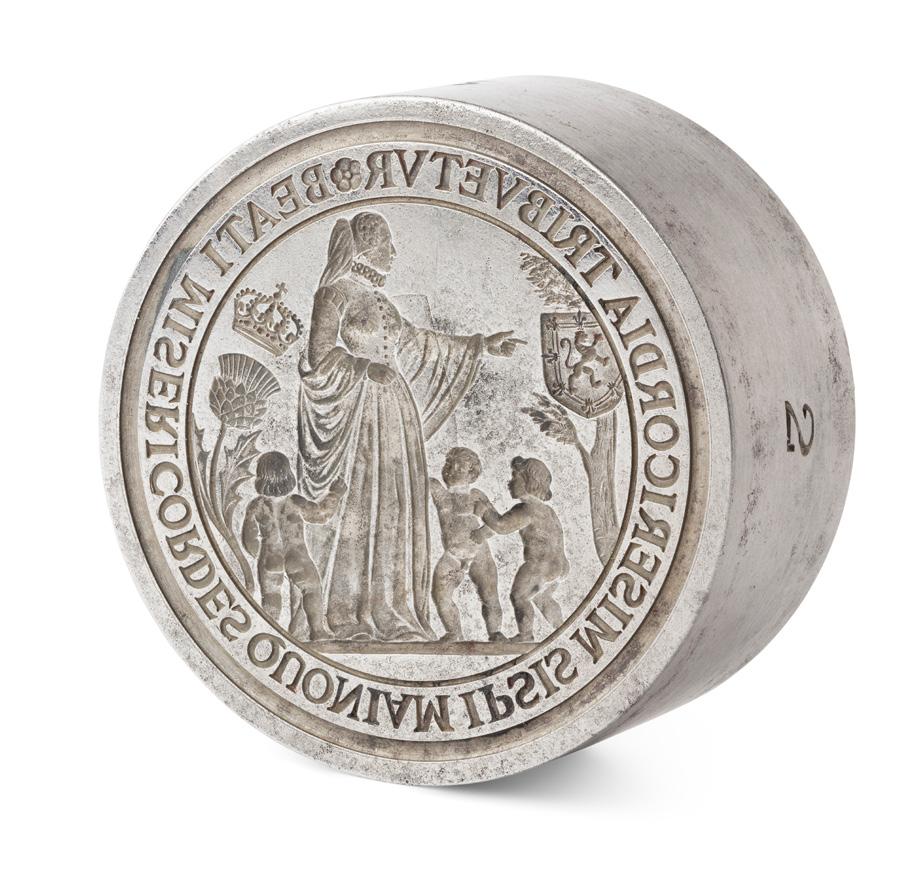
Diameter: 52mm
Note: The Royal Scottish Corporation is the working name of the ‘The Scottish Hospital of the Foundation of King Charles II’
First incorporated by Royal Charter in 1665 and dating its origins to 1603, it is the oldest Scottish charity outside of Scotland and one of the oldest in London and the UK.
Education has always been a priority, initially training orphans and ablebodied Scots for ‘manual occupations’ and the ‘advancement of trade’.
Still in existence today, the charity focuses on helping Scots in London
£300-500
THE ROYAL BURGH OF BANFF DESK SEAL
A MID-18TH-CENTURY MAHOGANY AND STEEL DESK SEAL
the handle modelled as a chess pawn with a reeded collar, the circular steel matrix engraved with the arms of the Royal Burgh of Banff, the inscription to border ‘SIGILLUM COMMUNE DE BANFF’
Length: 10cm, matrix diameter: 48mm
Provenance: Matrix: A Collection of British Seals - David Morris 2012Seal 24, page 66

£500-800
72
GLASGOW - A SCOTTISH DESK SEAL
A STEEL DESK SEAL
of circular form, engraved to the disc with the Glasgow coat of arms and motto
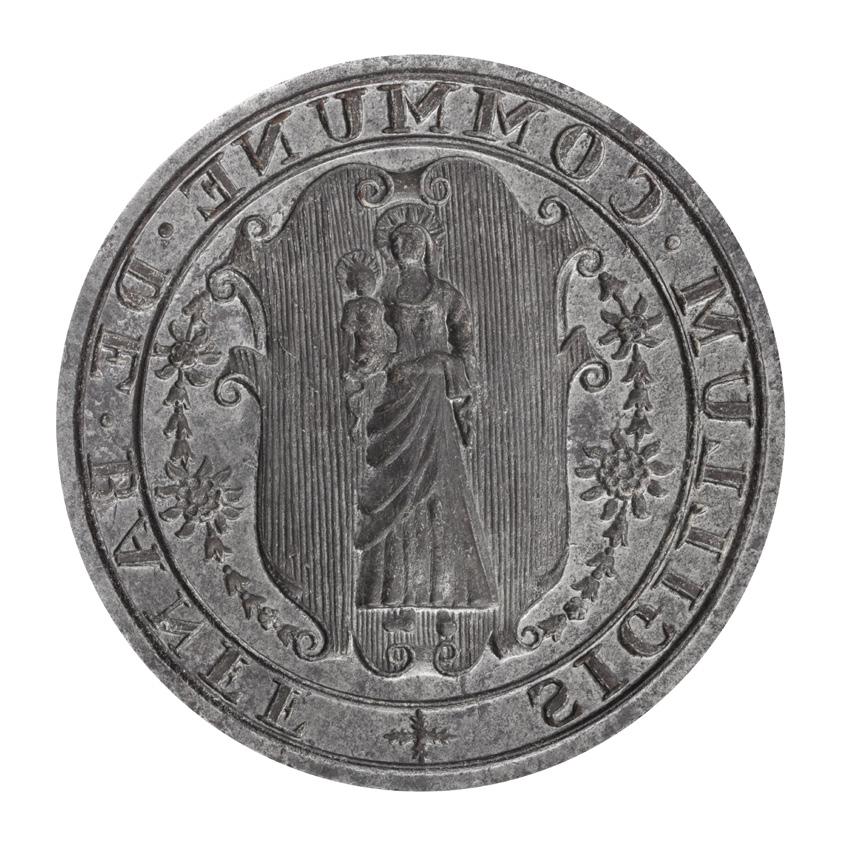
Diameter: 31mm
£80-120
73
PERTHSHIRE
A WOODEN AND BRASS DESK SEAL

the baluster handle to a brass collar and matrix, engraved PAROCHIAL BOARD RATTRAY
Length: 80mm, matrix: 19mm x 7mm
£120-180
74
A LATE 19TH-CENTURY WOODEN AND MIXED METAL DESK SEAL, CIRCA 1880 the turned wooden handle of baluster form, to a brass collar and pewter matrix, engraved ‘Aberdeen Post Office NB’ as a garter with crown to the middle

Length: 10.5cm, matrix: 27mm x 22mm
Provenance: Matrix: A Collection of British Seals - David Morris 2012 - Seal 141, page 264
Note: Aberdeen is a Civil Parish in Carleton County, New Brunswick, Canada. the communities within it currently comprise of Argyle, Juniper, Juniper Station, Knowlesville and Glassville. Glassville takes its name from Reverend Charles Gordon Glassville, who studied at the University of Aberdeen and came to New Brunswick, serving as a Presbyterian minister in the 1850s. He also encouraged more settlers from Scotland.
More than 130 emigrants left the port of Greenock, Scotland on May 9, 1861, on board the barque “Irvine”, destined for the new settlement of Glassville. By June 27, 1861, they arrived at the Partridge Island quarantine station in Saint John Harbour and then travelled to Glassville to join the community which had already been established additional families joined the first settlers. The settlement grew quickly and had a post office from 1861, and by 1871 was the centre of five communities with a population of 200. By 1898, in addition to a post office, Glassville had six stores, a hotel, a Presbyterian church and a population of about 300.
£300-500
A LATE-18TH-CENTURY WOODEN AND BRASS DESK SEAL


the baluster handle to a brass collar and matrix, engraved with ‘PREPARED BY JOSEPH WESSELS SURGEON GENUINE PATENT JESUITS DROPS’
Length: 88mm, matrix diameter: 20mm
Note: Printed in The Edinburgh Advertiser, Tuesday 11th February 1772, an advertisement for Dr. Walker’s Patent Genuine Jesuit Drops ’CAUTION to the PUBLIC.
By the King’s Patent
DR. WALKER’S PATENT GENUINE JESUITS DROPS ...at 2s. 6d. each bottle; and specific purging remedy, at 2s 6d. per pot which are the most certain, cheap, pleasant, safe, effectual and immediate cure ever discovered for gleets, and seminal weaknesses...’
Robert Walker obtained the King’s Royal Letters Patent for his remedy in 1755, and rested heavily on the religious connotation of Jesuits, to promote his medicinal relief, similar to the Carmelite nuns before him and their carmelite drops. Dr. Walker’s concoction was in fact an elixir to alleviate venereal disease. After his death, surgeon Joseph Wessels adopted the marketing with Wessel’s Jesuit Drops, on sale as late as the 1870s.
£400-600
THE SCOTTISH AUSTRALIAN INVESTMENT COMPANY SEAL
A LATE 19TH-CENTURY STEEL DESK SEAL
the circular disk engraved with the Royal Standard for Scotland in between two unicorns and below a crown, with the legend surrounding, ‘THE SCOTTISH AUSTRALIAN INVESTMENT COMPANY LIMITED, ESTABLISHED IN 1840, LONDON AND AUSTRALIA, SOUTH AUSTRALIA

Diameter of matrix: 65mm
Note: The Scottish Australian Company was formed in Aberdeen in 1840 and later incorporated in England in 1856. It commenced activities after its formation, making substantial investments in the mining and pastoral industries in particular. The company had 416 ‘co-partners’ within the first year of its inception. During this period Aberdeen was enjoying a period of prosperity due to the immense success of the linen industry which meant there was ample capital to invest in Australia. This resulted in the Scottish Australian Investment Company becoming incredibly successful. The company had offices in both Sydney at O’Connell Street and 24 Gresham Street in London. In 1859 a subsidiary of the company was created, the Scottish Australian Mining Company, which was also incredibly successful.
£400-800

COMMERCIAL BANK OF SCOTLAND LTD SEAL
AN EARLY 19TH-CENTURY LIGNUM VITAE AND BRASS DESK SEAL
the baluster wooden handle, with a brass collar neck, the engraved brass circular terminal with a possible depiction of Edinburgh’s Royal Mile area, in a border, engraved with COMMERCIAL BANKING COMPANY OF SCOTLAND, a pin to the neck allows the border of the collar to be removed
Length: 23cm
Note: The wording of ‘Commercial Banking Company’ dates this seal between 1810 and 1832 when the bank changed its name to Commercial Bank of Scotland.


Furthermore, the image on the seal possibly relates to the relocated head offices in 1814 at the top of the High Street, from Picardy Place in Leith
The Commercial Bank of Scotland Ltd was founded in 1810 and obtained a royal charter in 1831. The bank grew substantially during the nineteenth and twentieth centuries until 1950 when it merged with the National Bank of Scotland to become the National Commercial Bank of Scotland. The commercial bank was formed as a result of public dissatisfaction with the three charter banks, the Bank of Scotland, the British Linen Bank, and the Royal Bank of Scotland. By 1940, the Commercial Bank of Scotland had the largest network in Scotland, amassing a system of 385 branches. The post-war period was one of radical change for Scottish banks with mergers and fresh links with English banks. In 1958, the Commercial Bank of Scotland merged with the National Bank of Scotland and later became subsumed by the Royal Bank of Scotland.
£300-500
78
THE GRAND DUKE OF MECKLENBURG SCHWERIN CONSULATE DESK SEAL

A LATE VICTORIAN OLIVE WOOD AND BRASS DESK SEAL, CIRCA 1880
the large turned olive wood baluster handle with reeded details, the oval brass matrix with the Grand Ducal arms and supporters with the Royal Crown above, the motto Grand Duke of Mecklenburg Schwerin Consulate Glasgow around
Length: 10.1cm, matrix: 31mm x 35mm
£400-600
Note: The Grand Duchy of Mecklenburg-Schwerin was established in 1815 from the old Duchy in Northern German. It remained in existence until the German Revolution of 1918 when it became a free state. As a German Grand Duchy, it maintained a number of Consulates in Britain including the main branch in London, located at 124 Fenchurch Street.
79
JOHN
A LATE 19TH-CENTURY MAHOGANY DESK SEAL
the baluster handle with concave terminal, the steel collar to an integral matrix, engraved with a crest in a border ‘JOHN DALZIEL NOTARY
PUBLIC EDINBURGH’
Length: 97mm, matrix diameter: 30mm
£250-350
THE ARCHBISHOP SPOTTISWOODE (1565-1639) SEAL

A 17TH-CENTURY BASE METAL SEAL
the seal of navette outline, with a depiction of St. Andrew with the Saltire in a border SIGILLVM * R *
D * IOHANNIS * ARCHIEPISCOPI * SANCTI * ANDREA, with an integral crescent handle to the reverse
Length: 95mm
£800-1,200
Note: Archbishop John Spottiswood was a highly important figure within the Scottish Church and worked at the highest levels of society.
Born in 1565 the eldest son of a Minister, he was educated at Glasgow University. He would take over from his father in the Parish of Calder in 1583 only two years after leaving Glasgow.
His rise within society is noted by 1601 when he was a Chaplin to the Duke of Lennox in the embassy to the French Court. He was with King James VI and I in England on his accession, once again showing his close relationship with Court.
He was nominated to the seat of Glasgow the same year but not consecrated until 1610. His religious views appear to have changed over time, softening from his initial ardent strict Presbyterian attitudes. Some may consider this softening of views with his closer alignment to the Royal Court and the views he chose to share often supported the views of the King. He was a supporter in the suppression of kirk powers that encroached
on Royal authority and indeed aimed to align the Scottish practices with the English Church.
In 1610 he presided as moderator and during this time the supremacy of Presbytery was abolished, it was not long after this his consecration was made official by the Bishops of London, Ely, Rochester and Worcester. He was made Archbishop of St Andrews and primate of Scotland in 1618.
He would continue a close and highly important relationship with the Royal Court and in 1633 would crown Charles I at the Palace of Holyrood in Edinburgh.
He published within his lifetime and, while not all would agree with his greatness must be considered an instrumental figure in 17th-century Scottish life and religion.
See National Portrait Gallery Collection for a contemporary portrait
John Spottiswoode by Wenceslaus Hollar - etching, circa 1655; published 1668 NPG D9946
81
THE ST. ANDREW’S CHILDREN’S CHURCH SEAL

A VICTORIAN STEEL SEAL MATRIX, CIRCA 1860
the cylindrical steel body with a navette shaped raised matrix, the motto SAINT ANDREW’S CHILDREN’S CHURCH around a saltire with laurel leaves Length: 45mm (overall), matrix: 35mm x 21mm

£100-200
82
AN EARLY BISHOP OF ARGYLL SEAL
A MEDIEVAL COPPER DESK SEAL
the integral matrix of oval outline engraved with the arms of Campbell of Argyll, in a border ‘S(gillium) CAPITULI ARGADIENSIS’, to a stylised handle with loop Matrix: 53mm x 43mm

Heraldry: The Arms of Campbell, Bishop of Argyll Arms: Gyronny or and sable
The arms are ensigned with proto mitre and surmounted with a crozier to denote the office of bishop. The seal also as the inscription around the edge of the matrix which reads ‘‘S(IGLLIUM) CAPITULI ARGADIENSIS’.
Note: The Latin translation ‘Seal of the Cathedral’s Capitulum of Argyle’ Upon examination of the lists of early Bishops of Argyll, there appear to be two candidates for the ownership of this seal. The first being Neil Campbell (died circa 1613 or 1627). It is thought that he was the Neil Campbell who graduated from the University of St Andrews with a Master of Arts in 1575 and that he became parson of Kilmartin and precentor of Lismore Cathedral in 1574. The second candidate for the ownership of this seal was Neil’s son, John who served as the Bishop of Argyll from the 1st June 1608 for about four and half years, dying in January 1613. £600-800
83
THE GLASGOW CATHEDRAL OR HIGH KIRK OF GLASGOW DESK SEAL AN EARLY TO MID 19TH-CENTURY CENTURY WOODEN AND BRASS DESK SEAL
the baluster handle with turned detail to terminal, the brass matrix of oval outline, with the coat of arms of the city of Glasgow in a border engraved WARDEN’S OFFICE CATHEDRAL
Length: 86mm, matrix: 15mm x 13mm
Note: The oldest cathedral in Scotland, the building of Glasgow Cathedral began in 1136 and took around 350 years to complete.
The cathedral is dedicated to the 6th century Christian missionary Saint Mungo, who became the patron saint of Glasgow, and whose tomb lies at the centre of the building’s Lower Church.
The motto for Glasgow, ‘Let Glasgow flourish’ is inspired by Mungo’s original call “Let Glasgow flourish by the preaching of the word”.
The 16th-century Scottish Reformation took its toll on the church and it wasn’t until I579 when the members of the Glasgow Trades House stepped in to defend the cathedral from further depredation that the church was saved.
£250-350
84
MAJOR GORGES MARCUS IRVINE (1760-1847) DESK SEAL
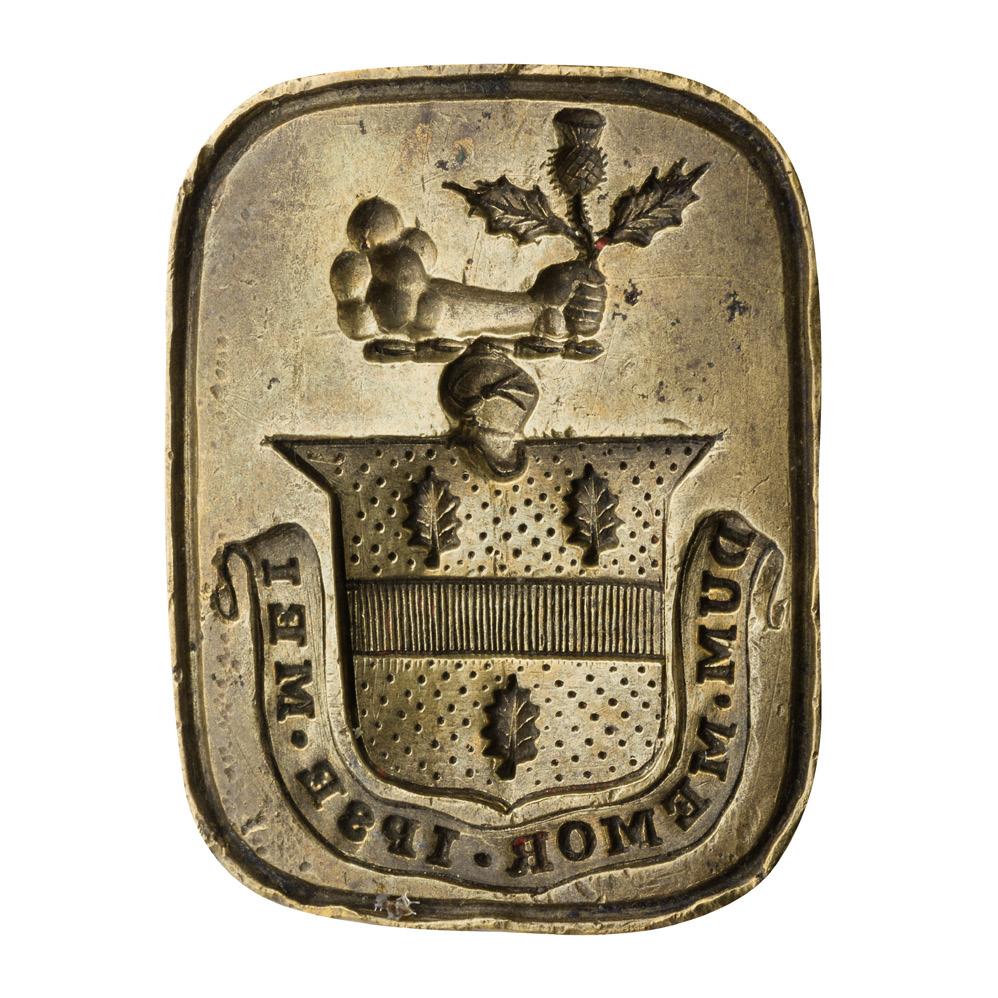
AN EARLY 19TH-CENTURY EBONY AND BRASS SEAL

the ebony baluster handle with bulbous head, to a brass matrix, engraved with the arms of Irvine
Length: 97mm, matrix: 21mm x 26mm
Heraldry: Arms: Or a fess gules between three holly leaves proper Crest: A dexter in armour fesswise issuant out of a cloud the hand proper holding a thistle also proper Motto: Dum memory ipse mei (While I am mindful of myself)
Note: Major Gorges Marcus Irvine was born on 26th November 1760 in Castle Irvine, Country Fermanagh, Ireland, to William Irvine and Sophia (Lowther) Irvine. He was the eldest surviving son and inheritor of the Irvine estate. The Irvine family mottos were sub umbra sub sole virescens, meaning ‘flourishing both in sunshine and in shade’, and dum memor ipse mei, seen on the seal, translating to ‘while I am mindful of myself’.
£250-350
85
COLONEL SIR JOHN PRINGLE
DALRYMPLE 5TH BARONET OF HAILES (1774-1829) SEAL
AN EARLY 19TH-CENTURY HARDWOOD AND BRASS SEAL

the simple turned hardwood handle of tapering form, to a brass collar and matrix, engraved with the arms of Dalrymple of Hailes
Length: 10.5cm, matrix: 23mm x 20mm
Heraldry: Arms: Or on a saltire azure nine lozenges of the field a bordure of the second charged with four boars’ head coupled alternating with a like number of mullets of the field
The arms environed with the ribbon and badge of a baronet of Nova Scotia (or Scotland)
Crest: A rock proper
Motto: Firm
£500-700
Note: The Dalrymple family was a prestigious Scottish family, with members partaking in roles integral to Scottish society such as Historians, Advocates, and Lord Provost of Edinburgh. They were also possessors of the Baronetcy of Hailes, in 1709 the first Baronet of Hailes purchased Whitehills House, in East Lothian, renaming it Newhailes. Newhailes House is an 18th-century villa and was once famous for having one of the largest libraries in Europe.
John Pringle Dalrymple (1774-1829) was the fifth Baron. At the age of 18, he entered the military service as an ensign of the 90th Regiment of Foot (90th (Perthshire Volunteers) Regiment of Foot). He was awarded Knight of the Order of the Bath, on December 28th, 1807
A painting by George Watson (17671837) of John Pringle Dalrymple from the collection of the Newhailes Estate, and is now part of the National Trust for Scotland collection.
86
A VICTORIAN HARDSTONE DESK SEAL, CIRCA 1870
the ebony handle of baluster form, to a knopped stem, with silver gadrooned collar, the oval bloodstone matrix engraved with a banner inscribed HOSPITAL above numerals 42, flanked by sprays of thistles
Length: 87mm (overall), matrix: 20mm x 16mm
Note: Although the exact origin of this seal remains unknown it seems possible that it is connected with the 42nd (Royal Highland) Regiment of Foot, latterly, The Black Watch, and was for one of their hospitals built up around or after the many important battles. Some of their campaigns and postings were for many years so setting up infrastructure such as hospitals and equipping it with official paperwork, seals etc would have been standard practice and shows how important the hospitals were to the battalions. The displayed thistles are very like those seen on other military items and indeed can be seen on their cap badge. Although original ownership has been impossible to prove it does seem likely.
£500-800
A SCOT’S GUARD REGIMENTAL DESK SEAL

A LATE 19TH-CENTURY EBONISED WOOD AND CARNELIAN DESK SEAL
the wooden handle with a simple domed terminal, the metal collar to a carnelian matrix engraved with the badge of the Order of the Thistle mounted on an eight-point star as used by the Scot’s Guards regiment

Length: 84mm, matrix: 14mm x 6mm
Note: See Lyon & Turnbull, lot 162 in Select Jewellery and Watches, 2nd May 2019, for a pair of cufflinks with the Scot’s Guards badge
£400-600
A SCOTTISH MOTTO AND ORDER OF THE THISTLE ASSOCIATED DESK SEAL
AN EARLY 20TH-CENTURY MIXED METAL DESK SEAL the handle formed as a sphere with various Scottish motifs, an embossed thistle in a border ‘NEMO ME IMPUNE
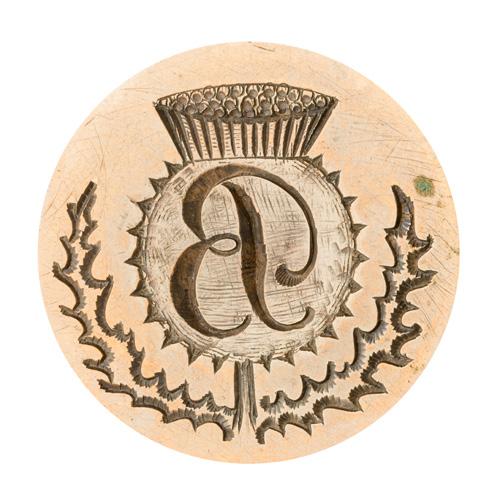

LACESSIT’, the stem and base heavily decorated with Scottish motifs and animals, the base engraved HAME IS AY HAME BE IT EVER SAE HAMELY’, the integral matrix engraved with an A in the flower of a thistle Length: 97mm, matrix diameter: 30mm
£400-600
89
THE FOB SEAL OF INSPECTOR-GENERAL SIR JAMES NICHOLS DICK
A VICTORIAN GILT METAL AND BLOODSTONE FOB SEAL, CIRCA 1880 the fluted and scrolling mount enclosing a shield-shaped chased bloodstone matrix, finely engraved with arms, crest and motto within a laurel leaf garland and with six medal pendants suspended below Length: 23mm, matrix: 9mm x 6mm
Note: The engraved arms of Inspector-General Sir James Nichols Dick K.C.B, C.B, L.K.Q.C.P, L.R.C.S, entered naval medical service in 1853, becoming Inspector General in 1884 before retiring in 1892. He served in both the Crimean and Abyssinian wars and was a Senior Medical Officer at the Royal Naval Hospital of Malta in 1882. He would go on to serve in the same role at the Royal Naval Hospital Haslar 1884-1887 and latterly apportioned Director General of the Naval Medical Department in 1888.
£150-250
90
AN EARLY VICTORIAN EDINBURGH POLICE COMBINATION SILVER MOUNTED TIPSTAFF AND SEAL, CIRCA 1840 the simple ebony cylindrical shaft with reeded mount to centre, with socket mounted pommel caps the upper with VR cypher with Royal crown above, the upper flat engraved with a seal of the city arms flanked by thistles and Edinburgh Police above, the lower mount engraved FIRST LIEUTENANT OF EDINBURGH POLICE


Length: 12.7cm, matrix 20mm diameter
Provenance: Matrix: A Collection of British Seals - David Morris 2012 - Seal 27, page 71
£600-800
91
AN EARLY VICTORIAN EDINBURGH POLICE COMBINATION SILVER MOUNTED TIPSTAFF AND SEAL, CIRCA 1840 the simple ebony cylindrical shaft with reeded mount to centre, with socket mounted pommel caps the upper with VR cypher with Royal crown above, the upper flat engraved with a seal of the city arms flanked by thistles and Edinburgh Police above, the lower mount engraved SUPERINTENDENT OF STREETS & BUILDINGS OF EDINBURGH POLICE
Length: 12.7cm, matrix 20mm diameter

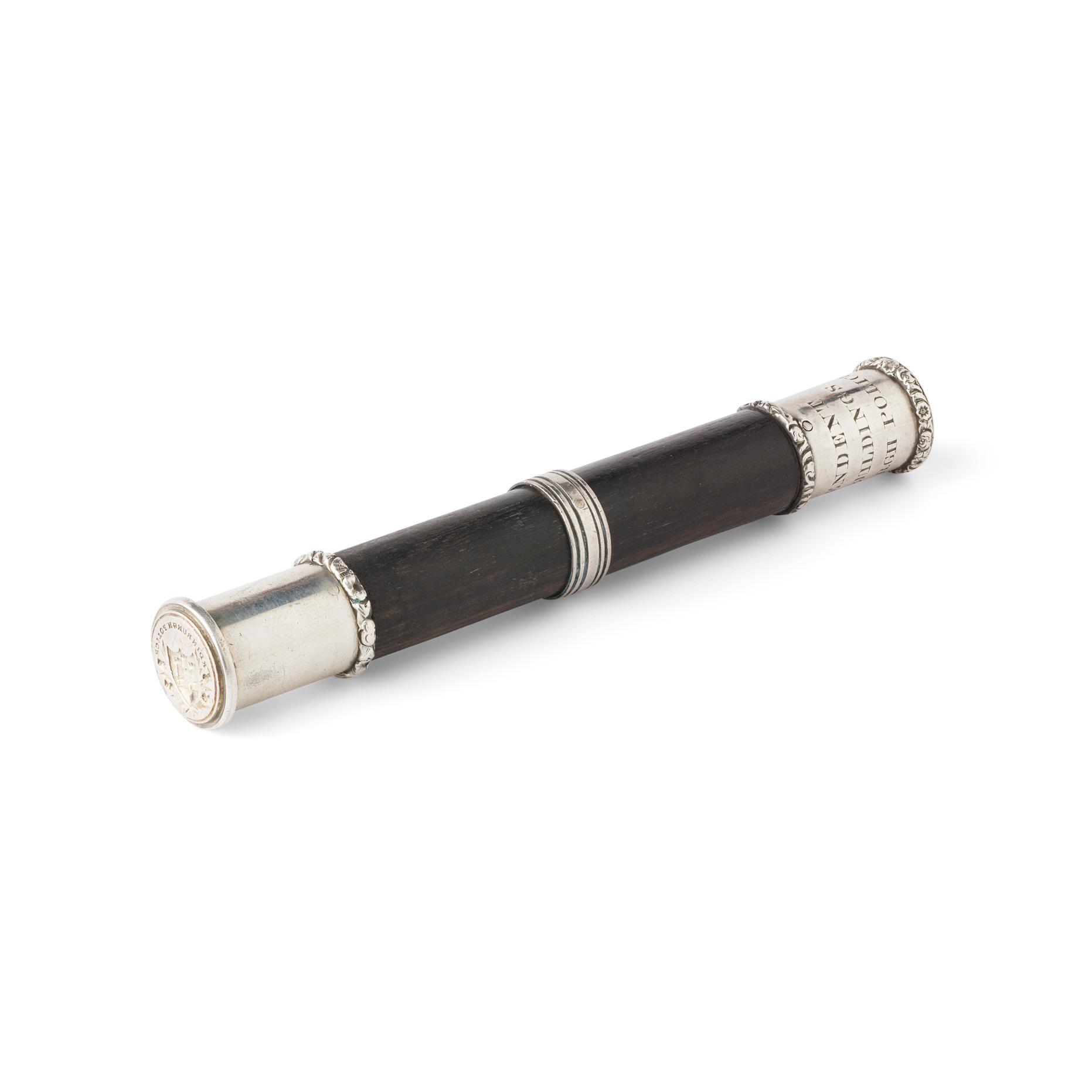

Provenance: Matrix: A Collection of British Seals - David Morris 2012- Seal 27, Pg 71
£600-800
Note: Tipstaves were carried by police officers from the late eighteenth century onwards as a badge of office, the forerunner of the modern warrant card. Originally the shaft was hollow to contain the document of authority.
The Edinburgh Police Act of 1805 replaced the old constabulary police system throughout the city, some 24 years before Sir Robert Peel founded the Metropolitan Police in London and brought in with it a uniform. The Edinburgh Police Force was administered until 1865 by a Police commission, and not by the town council. The rank of Lieutenant, used from 1812 in Scotland, came above inspector and below assistant superintendent, being roughly equivalent to an English chief inspector. It would appear that specific historic areas have used Tipstaffs for centuries to denote positions of authority but they do not typically combine a seal matrix.
While having the appropriate armorial or royal cipher is common to the end mount caps these two examples are among a very small number, if not the only, examples recorded with a seal matrix.


THE GLENURY ROYAL DISTILLERY SEAL
AN EARLY 19TH-CENTURY WOODEN AND BRASS DESK SEAL
the wooden handle of baluster form, with a knopped stem, the brass matrix circular outline, crown to centre in a border engraved ‘GLENURY ROYAL DISTILLERY’
Length: 9.5cm, matrix diameter: 29mm
Note: Glenury Royal Distillery was founded in 1825 by Captain James Barclay. Unlike the few other distilleries to have the title of ‘Royal’ it used this title from its earliest days as the founder was a friend of King William IV, rather than being awarded it by patronage over the years. This now closed Highland distillery in Stonehaven would be run by Barclay until 1858 when it would be sold in the first of many changes of ownership up to its eventual closure in 1985. The distillery, although in production most of its life did not release much if any, single malt whisky when it was active in the market instead of being a workhorse of the blending market. Very few official releases have been produced and these have always been in limited editions, including 40 and 50-year-old expressions.
£150-180
93
THE BUCK DISTILLERY DESK SEAL
A WOODEN, COPPER AND BRASS SEAL, BANFFSHIRE, CIRCA 1826 the turned wooden handle of baluster form, the applied brass terminal with engraved italic initials JS, the circular copper matrix engraved ‘BUCK DISTILLERY Js.SMITH’
Length: 99mm, matrix: 35mm x 35mm
Note: Buck Distillery was one of the early and few legally licensed distilleries in the Cabrach. The remote part of Speyside was renowned for its many illicit stills and no doubt its remote and unforgiving landscape gave rise to and success of many of these distillers. Buck Distillery was one of the few legal exceptions.
Likely a traditional farm distillery run parallel to the main business of farming it was granted a license in 1826 after the new licenses scheme came in only three years earlier in 1823. It survived until 1833 on the death of the founder James Smith.
Little is known of this long-lost distillery and it seems likely, other than the record of the license, this seal is the only relic of the distillery to survive.


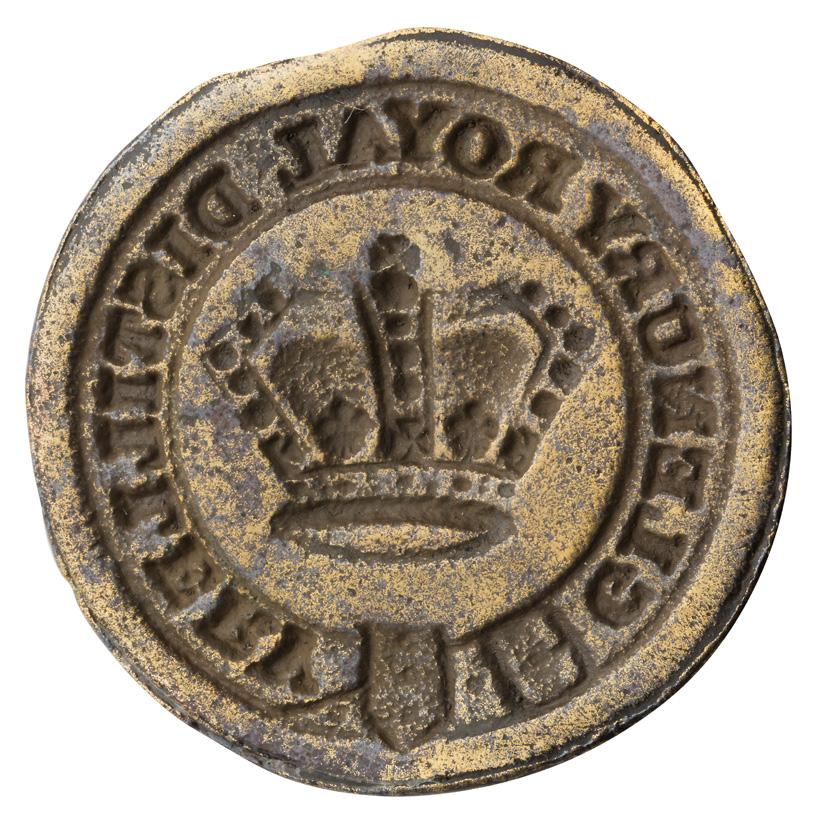
£200-300
94
THE COCKBURN & CAMPBELL ‘WHISKY’ SEAL
AN 18TH-CENTURY BRASS DESK SEAL
the brass circular disk engraved with ‘COCKBURN & CAMPBELL/ WHISKY’, to the reverse, marked ‘FARROW & JACKSON/ LONDON’ with screw fitting
Diameter of matrix: 52mm
£150-180
95
A VICTORIAN BRASS COMBINATION SPIRIT MERCHANT’S SEAL

CIRCA 1850
the brass baluster handle with twin matrices, the large pommel matrix engraved ‘Alexr Taylor Restauranteur & Spirit Merchant, 179 Trongate Glasgow’ screws off to reveal compartment containing four interchangeable matrices for WHISKY, SHERRY, RUM, CLARET and PORT, the smaller matrix engraved to outer border ‘Alexr Taylor Glasgow’ the inner section interchangeable
Length: 12cm, diameter of matrices 32mm and 25mm
£300-500
A MASONIC DESK SEAL - LODGE OF ST. MAHUTS LESMAHAGOW


A LATE 18TH-CENTURY WOODEN AND BRASS DESK SEAL
the baluster handle with a turned flat top, the brass circular matrix engraved with Masonic symbols and ‘No 22’, the border engraved ‘ST MAHUTS LODGE LESMAHAGOW’
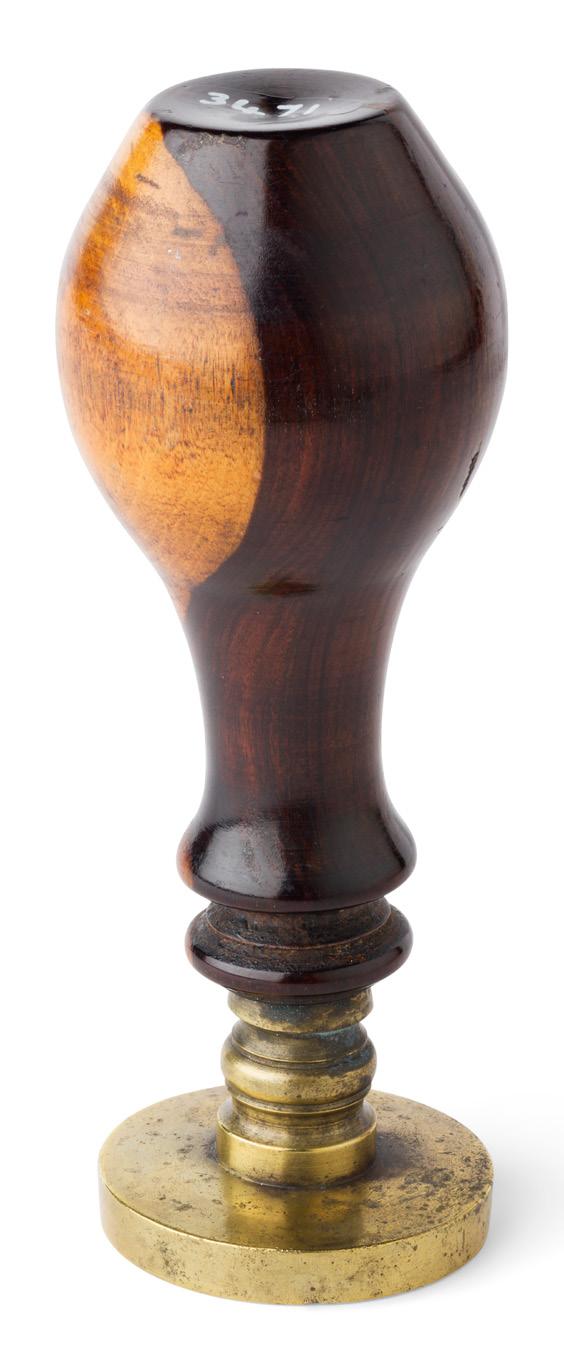
Length: 85mm, matrix diameter: 35mm
£150-250
97
THE GREENOCK DISTRICT LODGE OF THE LOYAL ORANGE INSTITUTION OF GREAT BRITAIN SEAL
A MID-VICTORIAN BRASS AND LABURNUM DESK SEAL, CIRCA 1850

the turned baluster laburnum handle to a large circular brass matrix, engraved with an image of King William on horseback with Wm III, 1690 below, surrounded but motto Loyal Orange
Institution of Great British, Greenock District Lodge No 3
Length: 12.3cm, matrix diameter: 41mm
Note: Although the origin of Orangism in Scotland can be traced much further back it was only by the mid 1850’s that the number of Lodges numbered greater than ten, Greenock Lodge being one of the early established and on this numbered as Lodge 3, although in some sources given as Lodge 8.
£400-600
98
ABERDEENSHIRE - A SCOTTISH PROVINCIAL MASONIC DESK SEAL
AN EARLY 19TH-CENTURY WOODEN AND SILVER DESK SEAL
unmarked, the turned wooden handle (replaced) to the domed seal with foliate collar and reeded decoration to reverse of matrix, the matrix reverse engraved for ‘Muir of Rhynie Lodge of Master Gardeners 1822’ and with emblems to the centre of crossed tools and dove of peace in flight
Length: 11cm, diameter of matrix: 47mm
Provenance: Lyon & Turnbull 17th August 2009, lot 364 (lacking handle)
Matrix: A Collection of British Seals - David Morris 2012 - Seal 31, page 78
Note: The inscription reads MUIR of RHYNIE LODGE OF MASTER GARDENERS / 1822. The seal is of the lodge of Master Gardeners in Muir of Rhynie, between the Firths of Dornoch and Cromarty in Aberdeenshire. The Muir of Rhynie Lodge was founded in 1812 and appears to have some closed sometime after 1834. Societies of Gardeners have existed in Scotland from the seventeenth century Initially formed by working gardeners to promote and encourage their profession by spreading horticultural knowledge and disseminating new plants, (many known as ‘Free Gardeners’) welcomed members from other professions and during the nineteenth century evolved into a combination of friendly society and Masonic Lodge. Some Gardeners’ Lodges joined together into orders, but others, such as this one, remained independent with their own complicated rituals. In general, the symbolism is based on the biblical story of the Creation and the Garden of Eden. The coded initials PGTE represented the four rivers of Eden, Pishon, Gihon, Tigris, and Euphrates) and the initials ANS represented Adam, Noah, and Solomon, with depictions of suitable images such as Noah’s dove or Adam and Eve standing hand in hand. As in Masonry, these would be combined with the gardening tools of the trade on the lodge’s regalia, which would be made locally to the required specifications. In the case of the Muir of Rhynie Lodge, unusually the gardening tools are crossed with three candlesticks, presumably representing enlightenment, and the initials SNA are accompanied by the so-far unidentified letter C. In other lodges, the letters can be found accompanied by a D for ‘dove’ or an O for ‘olive’
£800-1,200
99
ABERDEEN - A SCOTTISH PROVINCIAL FOB SEAL - MASONIC INTEREST
A LATE 19TH-CENTURY GOLD MOUNTED SMOKEY QUARTZ FOB SEAL
marked J.C. ABDN for James Crichton, or James Carr the oval facetted smoky quartz matrix with monogrammed initials in collet mount with pierced and engraved Masonic square and compass suspension

Length: 30mm, matrix: 25mm x 14mm
Note: For discussion on the confusion between these two makers and their connection to the J.C. makers mark, see Silver, The Aberdeen Story, Aberdeen Art Gallery & Museum, page 162 £600-800
100
THE UNION LODGE, DUNFERMLINE DESK SEAL - MASONIC INTEREST
A LATE 19TH-CENTURY WOODEN AND BRASS DESK SEAL

the wooden handle of baluster form, the brass collar to a circular matrix engraved with the triple flowers; thistle, rose and shamrock of the Union within a motto and inscription

Length: 95mm, matrix diameter: 47mm
Note: The Union Lodge, Dunfermline, Fife, was chartered on 1st November 1813. It became No. 250 between 1822 and 1826 and continued to use this number at least until 1951
£250-350
These Conditions of Sale and the Saleroom Notices as well as specific Catalogue terms, set out the terms on which we offer the Lots listed in this Catalogue for sale. By registering to bid and/or by bidding at auction You agree to these terms, we recommend that You read them carefully before doing so. You will find a list of definitions and a glossary at the end providing explanations for the meanings of the words and expressions used. Special terms may be used in Catalogue descriptions of particular classes of items (Books, Jewellery, Paintings, Guns, Firearms, etc.) in which case the descriptions must be interpreted in accordance with any glossary appearing in the Catalogue. These notices and terms will also form part of our terms and conditions of sales.
In these Conditions the words “Us”, “Our”, “We” etc. refers to Lyon & Turnbull Ltd, the singular includes the plural and vice versa as appropriate. “You”, “Your” means the Buyer. Lyon & Turnbull Ltd. acts as agent for the Seller. Lyon & Turnbull Ltd. acts as agent for the Seller. On occasion where Lyon & Turnbull Ltd. own a lot in part or full the property will be identified in the catalogue with the symbol (��) next to its lot number.
Whilst we seek to describe Lots accurately, it may be impractical for us to carry out exhaustive due diligence on each Lot. Prospective Buyers are given ample opportunities to view and inspect before any sale and they (and any independent experts on their behalf) must satisfy themselves as to the accuracy of any description applied to a Lot. Prospective Buyers also bid on the understanding that, inevitably, representations or statements by us as to authorship, genuineness, origin, date, age, provenance, condition or Estimated selling price involve matters of opinion. We undertake that any such opinion shall be honestly and reasonably held and only accept liability for opinions given negligently or fraudulently. Subject to the foregoing neither we the Auctioneer or our employees or agents accept liability for the correctness of such opinions and no warranties, whether relating to description, condition or quality of Lots, express, implied or statutory, are given. Please note that photographs/ images provided may not be fully representative of the condition of the Lot and should not be relied upon as indicative of the overall condition of the Lot. All dimensions and weights are approximate only.
We do not provide any guarantee in relation to the nature of a Lot apart from our authenticity warranty contained in paragraph E.2 and to the extent provided below.
(a) Condition Reports: Condition Reports are provided on our Website or upon request. The absence of a report does not imply that a Lot is without imperfections. Large numbers of such requests are received shortly before each sale and department specialists and administration will endeavour to respond to all requests although we offer no guarantee. Any statement in relation to the Lot is merely an expression of opinion of the Seller or us and should not be relied upon as an inducement to bid on the Lot. Lots are available for inspection prior to the sale and You are strongly advised to examine any Lot in which You are interested prior to the sale. Our Condition Reports are not prepared by professional conservators, restorers or engineers. Our Condition Report does not form any contract between us and the Buyer. The Condition Reports do not affect the Buyer’s obligations in any way.
(b) Estimates: Estimates are placed on each Lot to help Buyers gauge the sums involved for the purchase of a particular Lot. Estimates do not include the Buyer’s Premium or VAT. Estimates are a matter of opinion and prepared in advance. Estimates may be subject to change and are for guidance only and should not be relied upon.
(c) Catalogue Alterations: Lot descriptions and Estimates are prepared in advance of the sale and may be subject to change. Any alterations will be announced on the Catalogue alteration sheet, made available prior to the sale. It is the responsibility of the Buyer to make themselves aware to any alterations which may have occurred.
3. WITHDRAWAL
Lyon & Turnbull may, at its discretion, withdraw any Lot at any time prior to or during the sale of the Lot. Lyon & Turnbull has no liability to You for any decision to withdraw.
4. JEWELLERY, CLOCKS & OTHER ITEMS
(a) Jewellery:
(i) Coloured gemstones (such as rubies, sapphires and emeralds) may have been treated to enhance their look, through methods such as heating and oiling. These methods are accepted practice but may make the gemstone less strong and/or require special care in future.
(ii) All types of gemstones may have been improved by some method. You may request a gemmological report for any Lot which does not have a report if the request is made to us at least
three weeks before the date of the sale and You pay the fee for the report in advance of receiving said report.
(iii) We do not obtain a gemmological report for every gemstone sold in our sales. Where we do get gemmological reports from internationally accepted gemmological laboratories, such reports may be described in the Sale Particulars. Reports will describe any improvement or treatment only if we request that they do so, but will confirm when no improvement or treatment has been made. Because of differences in approach and technology, laboratories may not agree whether a particular gemstone has been treated, the amount of treatment or whether treatment is permanent. The gemmological laboratories will only report on the improvements or treatments known to the laboratories at the date of the report.
(iv) For jewellery sales, all Estimates are based on the information in any gemmological report or, if no gemmological report is available, You should assume that the gemstones may have been treated or enhanced.
(b) Clocks & Watches: All Lots are sold “as seen”, and the absence of any reference to the condition of a clock or watch does not imply the Lot is in good condition and without defects, repairs or restorations. Most clocks and watches will have been repaired during their normal lifetime and may now incorporate additional/newer parts. Furthermore, we make no representation or warranty that any clock or watch is in working order. As clocks and watches often contain fine and complex mechanisms, Buyers should be aware that a general service, change of battery or further repair work, for which the Buyer is solely responsible, may be necessary. Buyers should also be aware that we cannot guarantee a watch will remain waterproof if the back is removed. Buyers should be aware that the importing watches such as Rolex, Frank Muller and Corum into the United States is highly restricted. These watches cannot be shipped to the USA and only imported personally. Clocks may be sold without pendulums, weights or keys.
(c) Alcohol: may only be sold to persons aged of 18 years and over. By registering to bid, You affirm that You are at least that age. All collections must be signed for by a person over the age of 18. We Reserve the right to ask for ID from the person collecting. Buyers of alcohol must make appropriate allowances for natural variations of ullages, conditions of corks and wine. We can provide no guarantees as to how the alcohol may have been stored. There is always a risk of cork failure and allowance by the Buyer must be made. Alcohol is sold “as is” and quality of the alcohol is entirely at the risk of the Buyer and no warranties are given.
(d) Books-Collation: If on collation any named item in the sale Catalogue proves defective, in text or illustration the Buyer may reject the Lot provided he returns it within 21 days of the sale stating the defect in writing. This, however, shall not apply in the case of unnamed items, periodicals, autographed letters, music M.M.S., maps, drawings nor in respect of damage to bindings, stains, foxing, marginal worm holes or other defects not affecting the completeness of the text nor in respect of Defects mentioned in the Catalogue, or at the time of sale, nor in respect of Lots sold for less than £300.
(e) Electrical Goods: are sold as “works of art” only and if bought for use must be checked over for compliance with safety regulations by a qualified electrician first. Use of such goods is entirely at the risk of the Buyer and no warranties as to safety of the goods are given.
(f) Upholstered items: are sold as “works of art” only and if bought for use must be checked over for compliance with safety regulations (items manufactured prior to 1950 are exempt from any regulations). Use of such goods is entirely at the risk of the Buyer and no warranties as to safety of the goods are given. We provide no guarantee as to the originality of any wood/material contained within the item.
B. REGISTERING TO BID
1. NEW BIDDERS
(a) If this is Your first time bidding at Lyon & Turnbull or You are a returning Bidder who has not bought anything from us within the last two years You must register at least 48 hours before an auction to give us enough time to process and approve Your registration. We may, at our discretion, decline to permit You to register as a Bidder. You will be asked for the following:
(i) Individuals: Photo identification (driving licence, national identity card or passport) and, if not shown on the ID document, proof of Your current address (for example, a current utility bill or bank statement)
(ii) Corporate clients: Your Certificate of Incorporation or equivalent document(s) showing Your name and registered address together with documentary proof of directors and beneficial owners, and;
(iii) Trusts, partnerships, offshore companies and other business structures please contact us directly in advance to discuss requirements.
(b) We may also ask You to provide a financial reference and/or a deposit to allow You to bid. For help, please contact our Finance Department on +44(0)131 557 8844.
2. RETURNING BIDDERS
We may at our discretion ask You for current identification as described in paragraph B.1.(a) above, a finance
reference or a deposit as a condition of allowing You to bid. If You have not bought anything from us in the last two years, or if You want to spend more than on previous occasions, please contact our Finance Department on +44(0)131 557 8844.
3. FAILURE TO PROVIDE THE RIGHT DOCUMENTS
If in our opinion You do not satisfy our Bidder identification and registration procedures including, but not limited to, completing any anti-money laundering and/or anti-terrorism financing checks we may require to our satisfaction, we may refuse to register You to bid, and if You make a successful bid, we may cancel the contract between You and the Seller.
4. BIDDING ON BEHALF OF ANOTHER PERSON
(a) As an authorised Bidder: If You are bidding on behalf of another person, that person will need to complete the registration requirements above before You can bid, and supply a signed letter authorising You to bid for him/ her.
(b) As agent for an undisclosed principal: If You are bidding as an agent for an undisclosed principle (the ultimate Buyer(s)) You accept personal liability to pay the Purchase Price and all other sums due, unless it has been agreed in writing with us before commencement of the auction that the Bidder is acting as an agent on behalf of a named third party acceptable to us and we will seek payment from the named third party.
5. BIDDING IN PERSON
If You wish to bid in the saleroom You must register for a numbered bidding paddle before You begin bidding. Please ensure You bring photo identification with You to allow us to verify Your registration.
6. BIDDING SERVICES
The bidding services described below are a free service offered as a convenience to our clients and we are not responsible for any error (human or otherwise), omission or breakdown in providing these services.
(a) Phone bids
Your request for this service must be made no later than 12 hours prior to the auction. We will accept bids by telephone for Lots only if our staff are available to take the bids. If You need to bid in a language other than English You should arrange this Well before the auction. We do not accept liability for failure to do so or for errors and omissions in connections.
(b) Internet Bids
For certain auctions we will accept bids over the internet. For more information please visit our Website. We will use reasonable efforts to carry out online bids and do not accept liability for equipment failure, inability to access the internet or software malfunctions related to execution of online bids/ live
bidding.
(c) Written Bids
While prospective Buyers are strongly advised to attend the auction and are always responsible for any decision to bid for a particular Lot and shall be assumed to have carefully inspected and satisfied themselves as to its condition we shall, if so instructed, clearly and in writing execute bids on their behalf. Neither the Auctioneer nor our employees nor agents shall be responsible for any failure to do so. Where two or more commission bids at the same level are recorded we Reserve the right in our absolute discretion to prefer the first bid so made. Bids must be expressed in the currency of the saleroom. The Auctioneer will take reasonable steps to carry out written bids at the lowest possible price, taking into account the Reserve. If You make a written bid on a Lot which does not have a Reserve and there is no higher bid than Yours, we will bid on Your behalf at around 50% of the lower Estimate or, if lower, the amount of Your bid.
C. DURING THE SALE
1. ADMISSION TO OUR AUCTIONS
We shall have the right at our discretion, to refuse admission to our premises or attendance at our auctions by any person. We may refuse admission at any time before, during or after the auction.
2. RESERVES
Unless indicated by an insert symbol (∆), all Lots in this Catalogue are offered subject to a Reserve. A Reserve is the confidential Hammer Price established between us and the Seller. The Reserve is generally set at a percentage of the low Estimate and will not exceed the low Estimate for the Lot.
3. AUCTIONEER’S DISCRETION
The maker of the highest bid accepted by the Auctioneer conducting the sale shall be the Buyer and any dispute shall be settled at the Auctioneer’s absolute discretion. The Auctioneer may move the bidding backwards of forwards in any way he or she may decide or change the order of the Lots. The Auctioneer may also; refuse any bid, withdraw any Lot, divide any Lot or combine any two or more Lots, reopen or continuing bidding even after the hammer has fallen.
4. BIDDING
The Auctioneer accepts bids from:
(a) Bidders in the saleroom;
(b) Telephone Bidders, and internet Bidders through Lyon & Turnbull Live or any other online bidding platform we have chosen to list on and;
(c) Written bids (also known as absentee bids or commission bids) left with us by a Bidder before the auction.
5. BIDDING INCREMENTS
Bidding increments shall be at the Auctioneer’s sole discretion.
6. CURRENCY CONVERTER
The saleroom video screens and bidding platforms may show bids in some other major currencies as Well as sterling. Any conversion is for guidance only and we cannot be bound be any rate of exchange used. We are not responsible for any error (human or otherwise) omission or breakdown in providing these services.
7. SUCCESSFUL BIDS
Unless the Auctioneer decides to use their discretion as set out above, when the Auctioneer’s hammer falls, we have accepted the last bid. This means a contract for sale has been formed between the Seller and the successful Bidder. We will issue an invoice only to the registered Bidder who made the successful bid. While we send out invoices by post/or email after the auction, we do not accept responsibility for telling You whether or not Your bid was successful. If You have bid by written bid, You should contact us by telephone or in person as soon as possible after the auction to get details of the outcome of our bid to avoid having to pay unnecessary storage charges.
8. RELEVANT LEGISLATION
You agree that when bidding in any of our sales that You will strictly comply with all relevant legislation including local laws and regulations in force at the time of the sale for the relevant saleroom location.
1. THE PURCHASE PRICE
For each Lot purchased a Buyer’s Premium of 26% of the Hammer Price of each Lot up to and including £20,000, plus 25% from £20,001 to £500,000, plus 20% from £500,001 thereafter. VAT at the appropriate rate is charged on the Buyer’s Premium. No VAT is payable on the Hammer Price or premium for printed books or unframed maps bought at auction. Live online bidding may be subject to an additional premium (level dependent on the live bidding service provider chosen). This additional premium is subject to VAT at the appropriate rate as above.
2. VALUE ADDED TAX
Value Added Tax is charged at the appropriate rate prevailing by law at the date of sale and is payable by Buyers of relevant Lots.
(a) Lots affixed with (†): Value Added Tax on the Hammer Price is imposed by law on all items affixed with a dagger
(†). This imposition of VAT maybe because the Seller is registered for VAT within the European Union and is not operating under a Margin Scheme.
(b) Lots affixed with (*): A reduced rate of Value Added Tax on the Hammer Price of 5% is payable. This indicates that a Lot has been imported from outwit the European Union. This reduced rate is applicable to Antique
items.
(c) Lots affixed with [Ω]: Standard rate of Value Added Tax on the Hammer Price and premium is payable. This applies to items that have been imported from outwit the European Union and do not fall within the reduced rate category outlined above.
This symbol § indicates works which may be subject to the Droit de Suite or Artist’s Resale Right, which took effect in the United Kingdom on 14th February 2006. We are required to collect a royalty payment for all qualifying works of art. Under new legislation which came into effect on 1st January 2012 this applies to living artists and artists who have died in the last 70 years. This royalty will be charged to the Buyer on the Hammer Price and in addition to the Buyer’s Premium. It will not apply to works where the Hammer Price is less than €1,000 (euros). The charge for works of art sold at and above €1,000 (euros) and below €50,000 (euros) is 4%. For items selling above €50,000 (euros), charges are calculated on a sliding scale. All royalty charges are paid to the Design and Artists Copyright Society (‘DACS’) and no handling costs or additional fees are retained by the Auctioneer. Resale royalties are not subject to VAT. Please note that the royalty payment is calculated on the rate of exchange at the European Central Bank on the date of the sale. More information on Droit de Suite is available at www.dacs.org.uk.
E. WARRANTIES
1. SELLER’S WARRANTIES
For each Lot, the Seller gives a warranty that the Seller;
(a) Is the owner of the Lot or a joint owner of the Lot acting with the permission of the other co-owners, or if the Sellers is not the owner of or a joint owner of the Lot, has the permission of the owner to sell the Lot, or the right to do so in law, and;
(b) Had the right to transfer ownership of the Lot to the Buyer without any restrictions or claims by anyone else. If either other above warranties are incorrect, the Seller shall not have to pay more than the Purchase Price (as defined in the glossary) paid by You to us. The Seller will not be responsible to You for any reason for loss of profits or business, expected savings, loss of opportunity or interest, costs, damages, other damages or expense. The Seller gives no warranty in relation to any Lot other than as set out above and, as far as the Seller is allowed by law, all warranties from the Seller to You, and all obligations upon the Seller which may be added to this agreement by law, are excluded.
2. AUTHENTICITY GUARANTEE
We guarantee that the authorship, period, or origin (collectively,
“Authorship”) of each Lot in this Catalogue is as stated in the BOLD or CAPITALISED type heading in the Catalogue description of the Lot, as amended by oral or written saleroom notes or announcements. We make no warranties whatsoever, whether express or implied, with respect to any material in the Catalogue other than that appearing in the Bold or Capitalised heading and subject to the exclusions below.
In the event we, in our reasonable opinion, deem that the conditions of the authenticity guarantee have been satisfied, it shall refund to the original purchaser of the Lot the Hammer Price and applicable Buyer’s Premium paid for the Lot by the original purchaser. This Guarantee does not apply if:
(a) The Catalogue description was in accordance with the opinion(s) of generally accepted scholar(s) and expert(s) at the date of the sale, or the Catalogue description indicated that there was a conflict of such opinions; or
(b) the only method of establishing that the Authorship was not as described in the Bold or Capitalised heading at the date of the sale would have been by means or processes not then generally available or accepted; unreasonably expensive or impractical to use; or likely (in our reasonable opinion) to have caused damage to the Lot or likely to have caused loss of value to the Lot; or
(c) There has been no material loss in value of the Lot from its value had it been in accordance with its description in the Bold or Capitalised type heading. This Guarantee is provided for a period of one year from the date of the relevant auction, is solely for the benefit of the original purchaser of the Lot at the auction and may not be transferred to any third party. To be able to claim under this Authenticity Guarantee, the original purchaser of the Lot must:
(a) notify us in writing within one month of receiving any information that causes the original purchaser of record to dispute the accuracy of the Bold or Capitalised type heading, specifying the Lot number, date of the auction at which it was purchased and the reasons for such dispute; and
(b) return the Lot to our registered office in the same condition as at the date of sale to the original purchaser of record and be able to transfer good title to the Lot, free from any third party claims arising after the date of such sale.
We have discretion to waive any of the above requirements. We may require the original purchaser of the Lot to obtain, at the original purchaser of Lot’s cost, the reports of two independent and recognised experts in the field. The reports must be mutually acceptable to us and the original purchaser of the Lot. We shall not be bound by any reports produced by the original purchaser of the Lot, and Reserves the
right to seek additional expert advice at its own expense. It is specifically understood and agreed that the rescission of a sale and the refund of the original Purchase Price paid (the successful Hammer Price, plus the Buyer’s Premium) is exclusive and in lieu of any other remedy which might otherwise be available as a matter of law. Lyon & Turnbull and the Seller shall not be liable for any incidental or consequential damages incurred or claimed, including without limitation, loss of profits or interest.
3. YOUR WARRANTIES
(a) You warrant that the funds used for settlement are not connected with any criminal activities, including tax evasion and You are neither; under investigation, have been charged with or convicted of money laundering, terrorist activities or other crimes.
(b) Where You are bidding on behalf of another person You warrant that:
(i) You have conducted appropriate customer due diligence on the ultimate Buyer(s) of the Lot(s) in accordance with all relevant anti-money laundering legislation, consent to us relying on this due diligence, and You will retain for a period of not less than five years the documentation evidencing the due diligence. You will make such documentation promptly available for immediate inspection by a third party auditor upon our written request to do so;
(ii) The arrangements between You and the ultimate Buyer(s) in relation to the Lot or otherwise do not, in whole or in part, facilitate tax crimes, and;
(iii) You do not know, and have no reason to suspect that the funds used for settlement are connected with the proceeds of any criminal activity, including tax evasion, or that the ultimate Buyer(s) are under investigation or have been charged with or convicted of money-laundering, terrorist activities, or other crimes.
F. PAYMENT
1. MAKING PAYMENT
(a) Within 7 days of a Lot being sold You will pay to us the Total Amount Due in cash or by such other method as is agreed by us. We accept cash, bank transfer (details on request), debit cards and Visa or MasterCard credit cards. Please note that we do not accept cash payments over £5,000 per Buyer per year.
(b) Any payments by You to us can be applied by us towards any sums owing by You to us howsoever incurred and without agreement by You or Your agent, whether express or implied.
(c) We will only accept payment from the registered Bidder. Once issued, we cannot change the Buyer’s name on an invoice or re-issue the invoice in a different name.
(d) The ownership of any Lots purchased shall not pass to You until You have made payment in full to us
of the Total Amount Due. The risk in and the responsibility for the Lot will transfer to You from whichever is the earlier of the following:
(i) When You collect the Lot; or
(ii) At the end of the 30th day following the date of the auction, or, if earlier, the date the Lot is taken into care by a third party unless we have agreed otherwise with You in writing.
(e) You shall at Your own risk and expense take away any Lots that You have purchased and paid for not later than 7 working days following the day of the auction or upon the clearance of any cheque used for payment whichever is later. We can provide You with a list of shippers. However, we will not be responsible for the acts or omissions of carriers or packers whether or not recommended by us.
(f) No purchase can be claimed or removed until it has been paid for.
(g) It is the Buyer’s responsibility to ascertain collection procedures, particularly if the sale is not being held at our main sale room and the potential storage charges for Lots not collected by the appropriate time.
2. IN THE EVENT OF NONPAYMENT
If any Lot is not paid for in full and taken away in accordance with these Conditions or if there is any other breach of these Conditions, we, as agent for the Sellers and on their behalf, shall at our absolute discretion and without prejudice to any other rights we may have, be entitled to exercise one or more of the following rights and remedies:
(a) To proceed against You for damages for breach of contract;
(b) To rescind the contract for sale of that Lot and/or any other Lots sold by us to You;
(c) To resell the Lot(s) (by auction or private treaty) in which case You shall be responsible for any resulting deficiency in the Total Amount Due (after crediting any part payment and adding any resale costs).
(d) To remove, store and insure the Lot in the case of storage, either at our premises or elsewhere and to recover from You all costs incurred in respect thereof;
(e) To charge interest at a rate of 5% a year above the Bank of Scotland base rate from time to time on all sums outstanding for more than 7 working days after the sale;
(f) To retain that or any other Lot sold to You until You pay the Total Amount Due;
(g) To reject or ignore bids from You or Your agent at future auctions or to impose conditions before any such bids shall be accepted;
(h) To apply any proceeds of sale of other Lots due or which become due to You towards the settlement of the Total Amount Due by You and to exercise a lien over any of Your
property in our possession for any purpose until the debt due is satisfied. You will be deemed to have granted such security to us and we may retain such property as collateral security for Your obligations to us; we may decide to sell Your property in any way we think appropriate. We will use the proceeds of the sale against any amounts You owe us and we will pay any amount left from that sale to You. If there is a shortfall, You must pay us the balance; and
(i) Take any other action we see necessary or appropriate.
G. COLLECTION & STORAGE
(1) It is the Buyer’s responsibility to ascertain collection procedures, particularly if the sale is not being held at our main sale room and the potential storage charges for Lots not collected by the appropriate time. Information on collection is set out in the Catalogue and our Website
(2) Unless agreed otherwise, You must collect purchased Lots within seven days from the auction. Please note the Lots will only be released upon full payment being received.
(3) If You do not collect any Lot within seven days following the auction we can, at our discretion;
(i) Charge You storage costs at the rates set out on our Website.
(ii) Move the Lot to another location or an affiliate or third party and charge You transport and administration costs for doing so and You will be subject to the third party storage terms and pay for their fees and costs.
(iii) Sell the Lot in any way we think reasonable.
H. TRANSPORT & SHIPPING
1. TRANSPORT AND SHIPPING
We will include transport and shipping information with each invoice sent to You as well as displayed on our Website. You must make all transport and shipping arrangements.
2. EXPORT OF GOODS
Buyers intending to export goods should ascertain;
(a) Whether an export licence is required; and
(b) Whether there is any specific prohibition on importing goods of that character, e.g. items that may contain prohibited materials such as ivory or rhino horn. It is the Buyer’s sole responsibility to obtain any relevant export or import licence. The denial of any licence or any delay in obtaining licences shall neither justify the recession of any sale not any delay in making full payment for the Lot.
3. CITES: ENDANGERED PLANTS AND ANIMALS LEGISLATION
Please be aware that all Lots marked with the symbol Y may be subject to CITES regulations when exporting these items outside the EU. These regulations may be found at http:// www.defra.gov.uk/ahvla-en/imports-
We accept no liability for any Lots which may be subject to CITES but have not be identified as such.
(a) We give no warranty in relation to any statement made, or information give, by us, our representatives or employees about any Lot other than as set out in the authenticity warranty and as far as we are allowed by law, all warranties and other terms which may be added to this agreement by law are exclude. The Seller’s warranties contained in paragraph E.1 are their own and we do not have a liability in relation to those warranties.
(b) (i) We are not responsible to You for any reason whether for breaking this agreement or any other matter relating to Your purchase of, or bid for, any Lot other than in the event of fraud or fraudulent misrepresentation by us other than as expressly set out in these conditions of sale; or
(ii) We do not give any representation, warranty or guarantee or assume any liability for a kind in respect of any Lot with regard to merchantability, fitness for a particular purpose, description, size, quality, condition, attribution, authenticity, rarity, importance, medium, provenance, exhibition history, literature or historical relevance, except as required by local law, any warranty of any kind is excluded by this paragraph.
(c) in particular, please be aware that our written and telephone bidding services, Lyon & Turnbull Live, Condition Reports, currency converter and saleroom video screens are free services and we are not responsible for any error (human or otherwise) omission or breakdown in these services.
(d) We have no responsibility to any person other than a Buyer in connection with the purchase of any Lot
(e) If in spite of the terms of this paragraph we are found to be liable to You for any reason, we shall not have to pay more than the Purchase Price paid by You to us. We will not be responsible for any reason for loss of profits, business, loss of opportunity or value, expected savings or interest, costs damages or expenses.
1. OUR ABILITY TO CANCEL
In addition to the other rights of cancellation contained in this agreement, we can cancel the sale of a Lot if;
(i) Any of our warranties are not correct, as set out in paragraph E3,
(ii) We reasonably believe that completing the transaction is or may be unlawful; or
(iii) We reasonably believe that the sale places us or the Seller under any liability to anyone else or may damage our reputation.
2. RECORDINGS
We may videotape and record proceedings at any auction. We will keep any personal information confidential, except to the extent disclosure is required by law if You do not wish to be videotaped, You may make arrangements to bit by telephone or a written bid or bid on Lyon & Turnbull Live instead. Unless we agree otherwise in writing, You may not videotape or record proceedings at any auction.
3. COPYRIGHT
We own the copyright in respect of all images, illustrations and written material produced by or for us relating to a Lot. (Including Catalogue entries unless otherwise noted in the Catalogue) You cannot use them without our prior written permission. We do not offer any guarantee that You will gain any copyright or other reproductions to the Lot.
4. ENFORCING THIS AGREEMENT
If a court finds that any part of this agreement is not valid or is illegal or impossible to enforce, that part of the agreement will be treated as deleted and the rest of this agreement will remain in force.
5. TRANSFERRING YOUR RIGHTS AND RESPONSIBILITIES
You may not grant a security over or transfer Your rights of responsibilities under these terms on the contract of sale with the Buyer unless we have given our written permission. This agreement will be binding on Your successors or estate and anyone who takes over Your rights and responsibilities.
6. REPORTING ON WWW.LYONANDTURNBULL.COM
Details of all Lots sold by us, including Catalogue disruptions and prices, may be reported on www.lyonandturnbull. com. Sales totals are Hammer Price plus Buyer’s Premium and do not reflect any additional fees that may have been incurred. We regret we cannot agree to requests to remove these details from our Website.
7. SALE BY PRIVATE TREATY
(a) The same Conditions of Sale (Buyers) shall apply to sales by private treaty.
(b) Private treaty sales made under these Conditions are deemed to be sales by auction and subject to our agreed charges for Sellers and Buyers.
(c) We undertake to inform the Seller of any offers it receives in relation to an item prior to any Proposed Sale, excluding the normal method of commission bids.
(d) For the purposes of a private treaty sale, if a Lot is sold in any other currency than Sterling, the exchange rate is to be taken on the date of sale.
8. THIRD PARTY LIABILITY
All members of the public on our premises are there at their own risk and must note the lay-out of
the premises, safety and security arrangements. Accordingly, neither the Auctioneer nor our employees or agents shall incur liability for death or personal injury or similarly for the safety of the property of persons visiting prior to, during or after a sale.
9. DATA PROTECTION
Where we obtain any personal information about You, we shall use it in accordance with the terms of our Privacy Policy (subject to any additional specific consent(s) You may have given at the time Your information was disclosed). A copy of our Privacy Policy can be found on our Website www. lyonandturnbull.com or requested from Client Services, 33 Broughton Place, Edinburgh, EH1 3RR or by email from data enquiries@lyonandturnbull. com.
10. FORCE MAJEURE
We shall be under no liability if they shall be unable to carry out any provision of the Contract of Sale for any reason beyond their control including (without limiting the foregoing) an act of God, legislation, war, fire, flood, drought, failure of power supply, lock-out, strike or other action taken by employees in contemplation or furtherance of a dispute or owing to any inability to procure materials required for the performance of the contract.
11. LAW AND JURISDICTION
(a) Governing Law: These Conditions of Sale and all aspects of all matters, transactions or disputes to which they relate or apply shall be governed by, and interpreted in accordance with, Scots law
(b) Jurisdiction: The Buyer agrees that the Courts of Scotland are to have exclusive jurisdiction to settle all disputes arising in connection with all aspects of all matters or transactions to which these Conditions of Sale relate or apply.
K. DEFINITIONS & GLOSSARY
The following words and phrases used have (unless the context otherwise requires) the meaning to given to them below. The go Glossary is to assist You to understand words and phrases which have a specific legal meaning which You may not be familiar with.
1. DEFINITIONS
“Auctioneer” Lyon & Turnbull Ltd
(Registered in Scotland No: 191166
| Registered address: 33 Broughton Place, Edinburgh, EH1 3RR) or it’s authorised representative conducting the sale, as appropriate;
“Bidder” a person who has completed a Bidding Form
“Bidding Form” our Bidding Registration Form our Absentee Bidding Form or our Telephone Bidding Form.
“Buyer” the person to whom a Lot is knocked down by the Auctioneer. The Buyer is also referred to by the words
“You” and “Your”
“Buyer’s Premium” the sum calculated on the Hammer Price at the rates stated in Catalogue.
“Catalogue” the Catalogue relating to the relevant Sale, including any representation on our Website
“Condition Report” the report on the physical condition of a Lot provided to a Bidder or potential Bidder by us on behalf of the Seller.
“Estimate” a statement of our opinion of the range within the hammer is likely to fall.
“Hammer Price” the level of bidding reached (at or above any Reserve) when the Auctioneer brings down the hammer;
“High Cumulative Value of Lot” several Lots with a total lower Estimate value of £30,000 or above;
“High Value Lot” a Lot with a lower Estimate of £30,000 or above;
“Lot” each Item offered for sale by Lyon & Turnbull;
“Purchase Price” is the aggregate of Hammer Price and any applicable Buyer’s Premium, VAT on the Hammer Price (where applicable), VAT on the Buyer’s Premium and any other applicable expenses;
“Reserve” the lowest price below which an item cannot be sold whether at auction or by private treaty;
“Sale” the auction sale at which a Lot is to be offered for sale by us.
“Seller” the person who offers the Lot for Sale. We act as agent for the Seller.
“Total Amount Due” the Hammer Price in respect of the Lot sold together with any premium, Value Added Tax or other taxes chargeable and any additional charges payable by a defaulting Buyer under these Conditions;
“VAT” value added tax at the prevailing rate at the date of the sale in the United Kingdom.
“Website” Lyon & Turnbull’s Website at www.lyonandturnbull.com
The following have specific legal meaning which You may not be familiar with. The following glossary is intended to give You an understanding of those expressions but is not intended to restrict their legal meanings:
“Artist’s Resale Right” the right of the creator of a work of art to receive a payment on Sales of that work subsequent to
“Knocked Down” when a Lot is sold to a Bidder, indicated by the fall of the hammer at the Sale.
“Lien” a right for the person who has possession of the Lot to retain possession of it.
“Risk” the possibility that a Lot may be lost, damaged, destroyed, stolen, or deteriorate in condition or value.
“Title” the legal and equitable right to the ownership of a Lot.
All potential buyers must register prior to placing a bid. Registration information may be submitted in person at our registration desk, by email, or on our website. Please note that first-time bidders, and those returning after an extended period, will be asked to supply the following documents in order to facilitate registration:
1 – Government issued photo ID (Passport/Driving licence)
2 – Proof of address (utility bill/bank statement).
We may, at our option, also ask you to provide a bank reference and/or deposit.
By registering for the sale, the buyer acknowledges that he or she has read, understood and accepted our Conditions of Sale.
At the Sale Registered bidders will be assigned a bidder number and given a paddle for use at the sale. Once the first bid has been placed, the auctioneer asks for higher bids in increments determined by the auctioneer. To place your bid, simply raise your paddle until the auctioneer acknowledges you. Please ensure that the auctioneer repeats your bidder number correctly when confirming the sale. If there is any doubt at this stage as to the hammer price or buyer it must be brought to the auctioneer’s attention immediately. All lots will be invoiced to the name and address given on your registration form, which is non-transferable.
A limited number of telephone lines are available for bidding by phone through a Lyon & Turnbull representative. Phone lines must be reserved in advance. All bid requests must be received an hour before the sale. All telephone bids must be confirmed in writing, listing the relevant lots and appropriate number to be called. We recommend that a covering bid is also left in the event that we are unable to make the call. We cannot guarantee that lines will be available, or that we will be able to call you on the day, but will endeavour to undertake such bids to the best of our abilities. This service is available entirely at our discretion and at the bidder’s risk.
Bid forms are available at the sale and/ or the back of the catalogue. These should be submitted in person, by post, or by fax as soon as possible prior to the sale and we will bid on your behalf up to the limit indicated. In the event of receiving two identical bids the first one received will take precedence All bids must be received an hour before the sale. This service is provided entirely at the bidder’s risk.
Leave a bid online through our website, call us on 0131 557 8844 or email info@lyonandturnbull.com
- BID LIVE ONLINE
Bid live online, for free, with Lyon & Turnbull Live. Just click the button from the auction calendar, sale page or any lot page online to register.
Our accounts teams will continue to be available to process payments and answer queries. We will be able to accept online payments through our website and bank transfer. On-site payment facilities are available by appointment.
Payment is due within seven (7) days of the sale. Lots purchased will not be released until full payment has been received. Payment may be made by the following methods:
Account details are included on any invoices we issue or upon request from our accounts department.
We no longer accept card payments by phone. Please use our online payment service (provided by Opayo).
You will find a link to this service in any email invoice issued or you can visit the payments section of our website.
No cash payments will be accepted for this auction.
Please refer to page 2 of this catalogue.
Inside Back Cover: Lot 340 [detail]